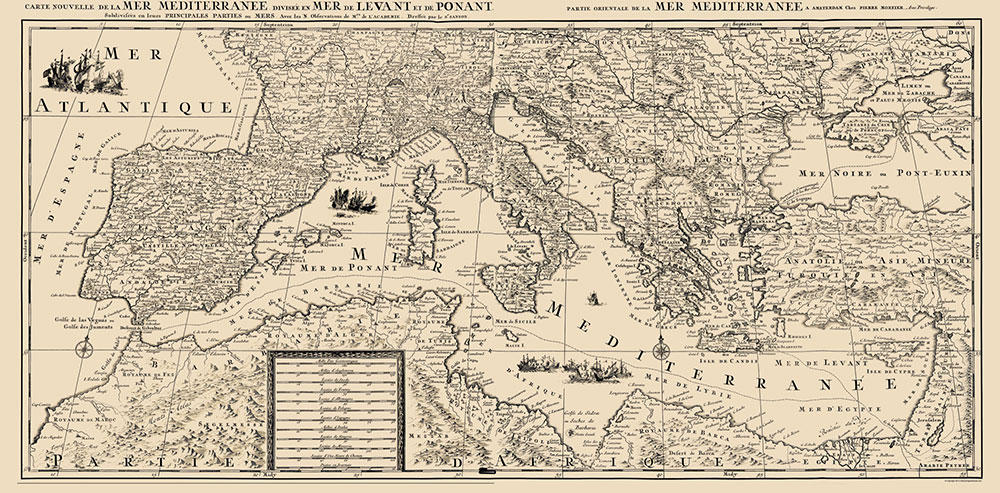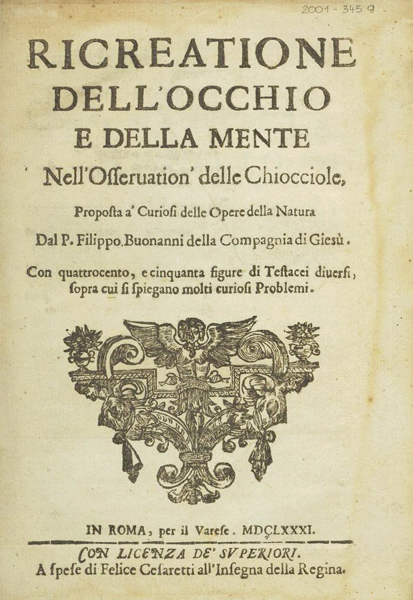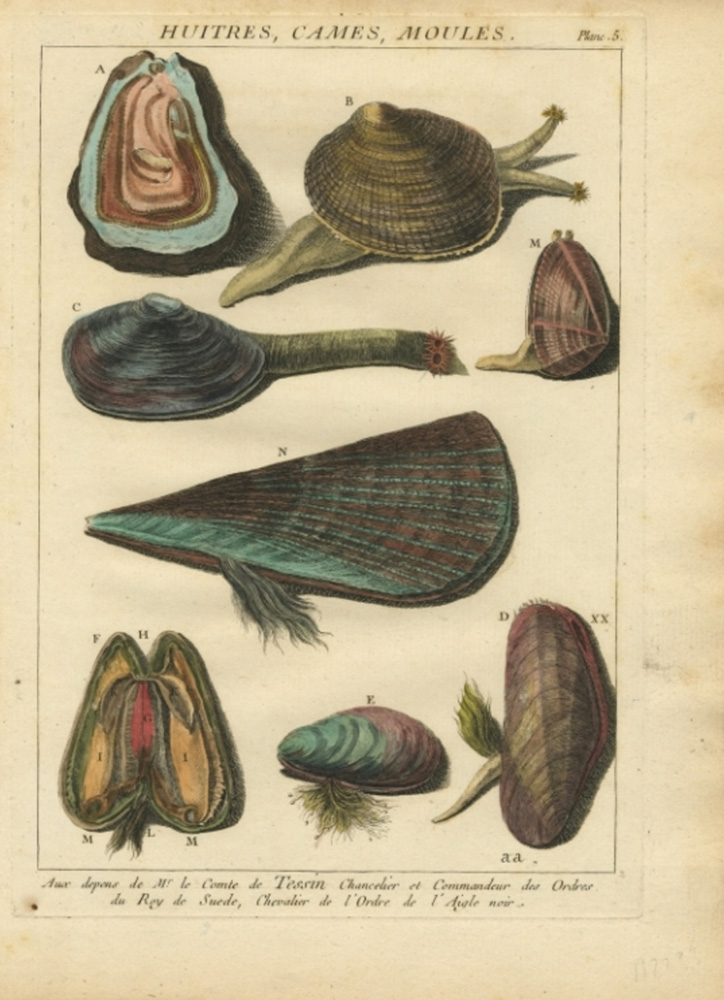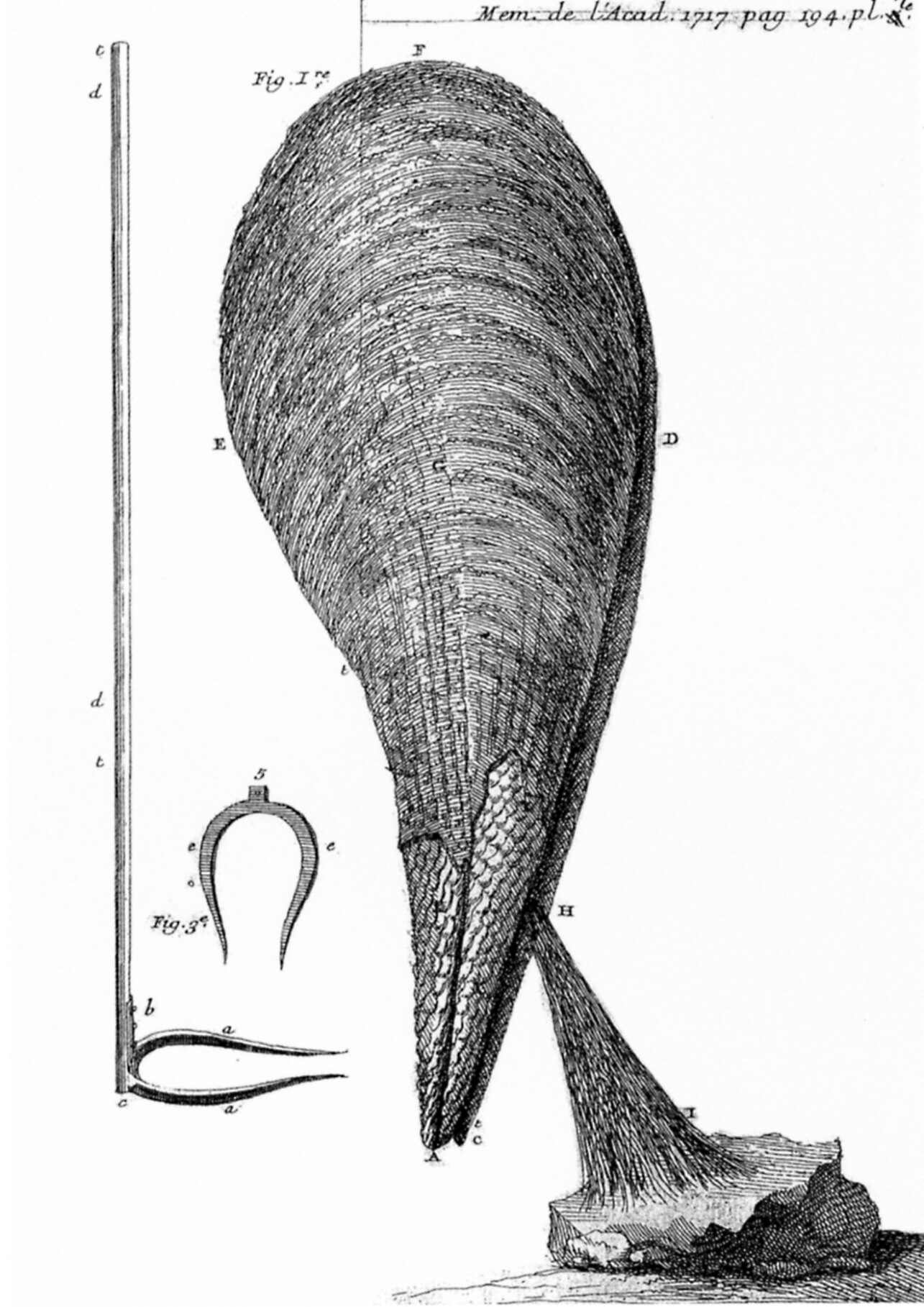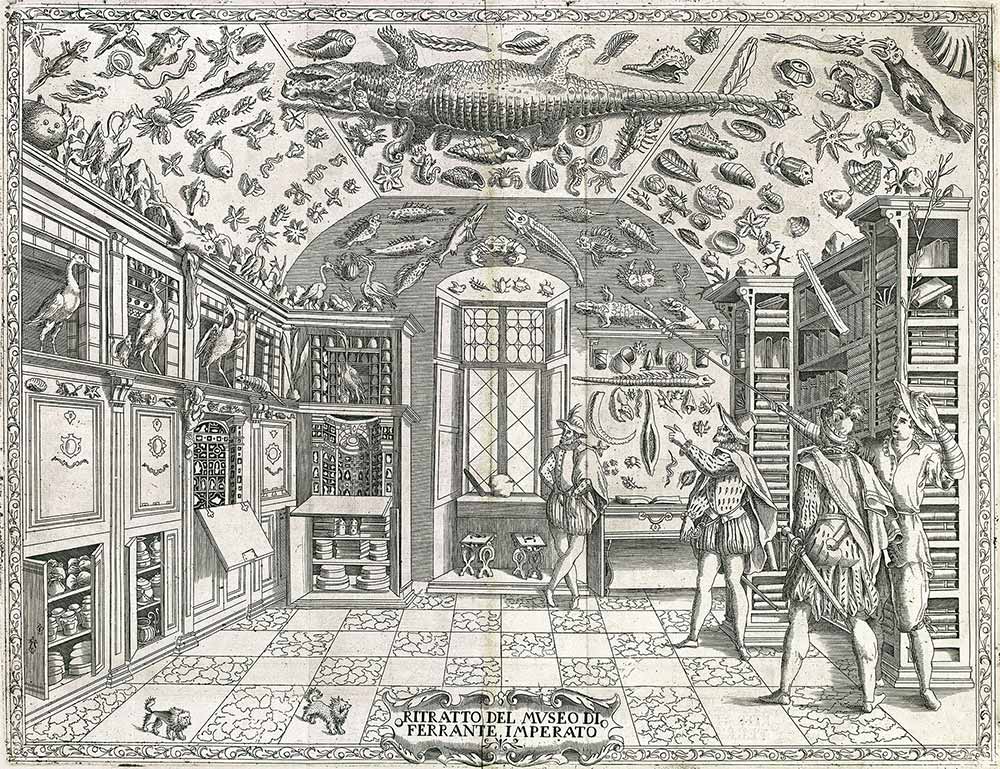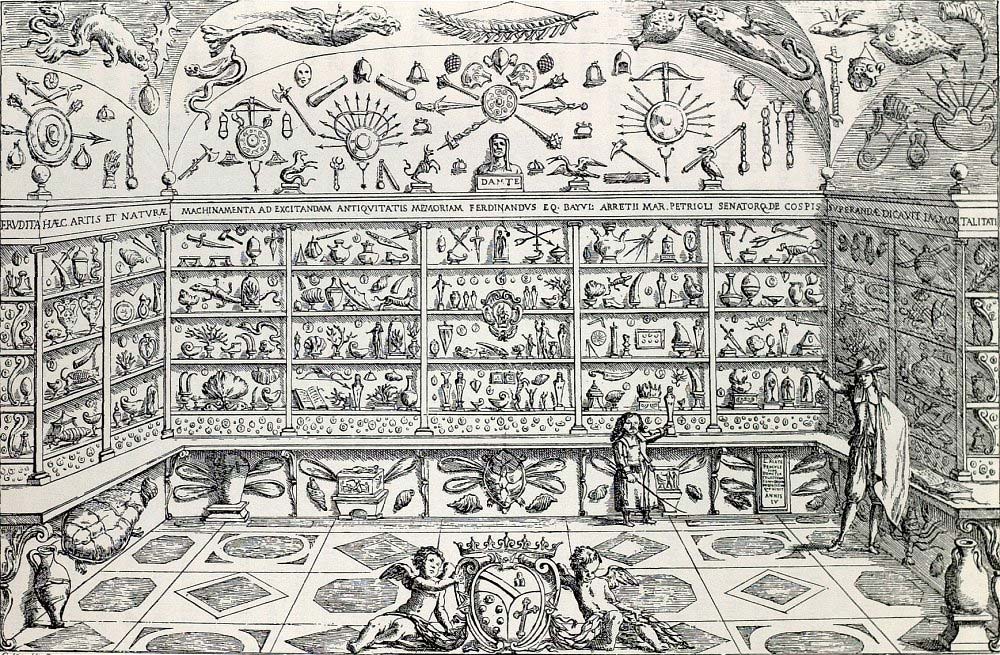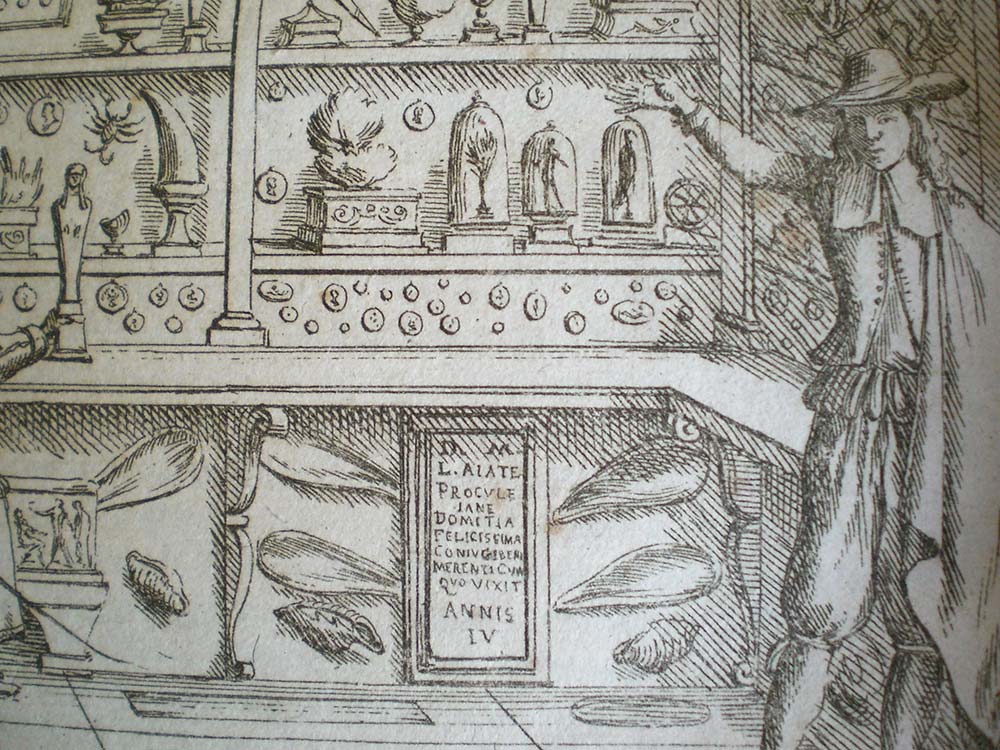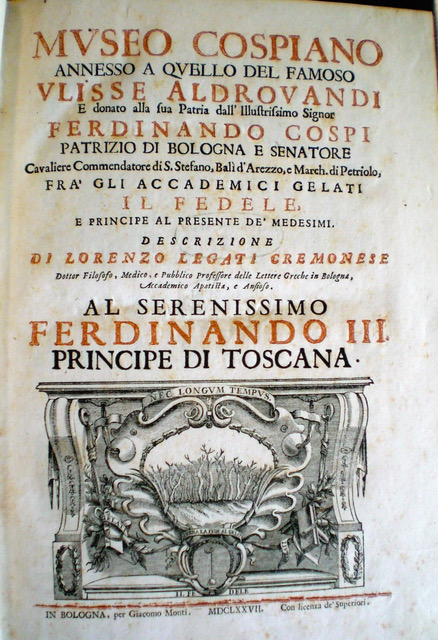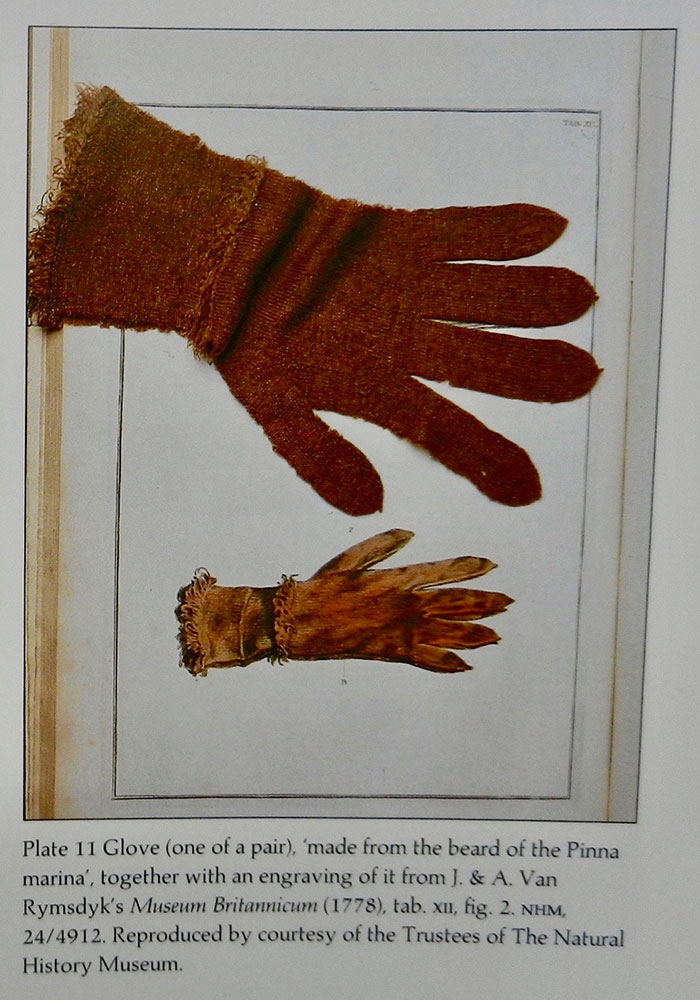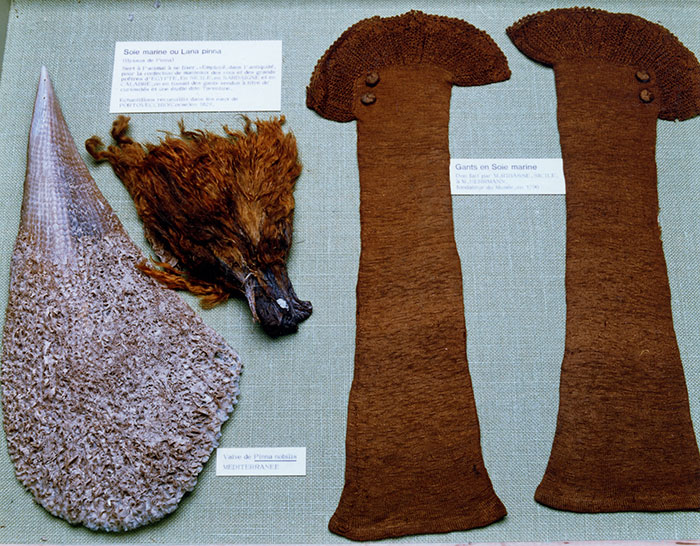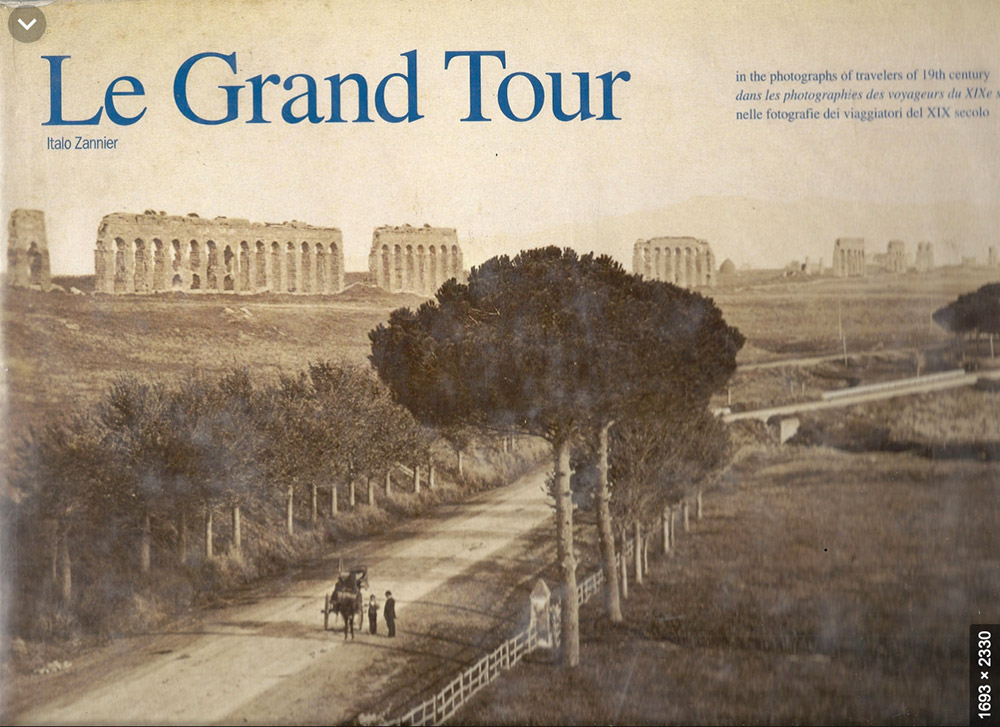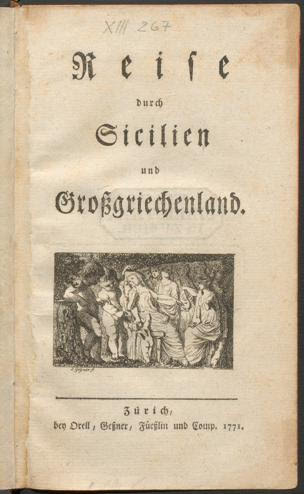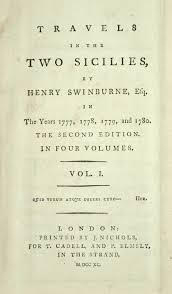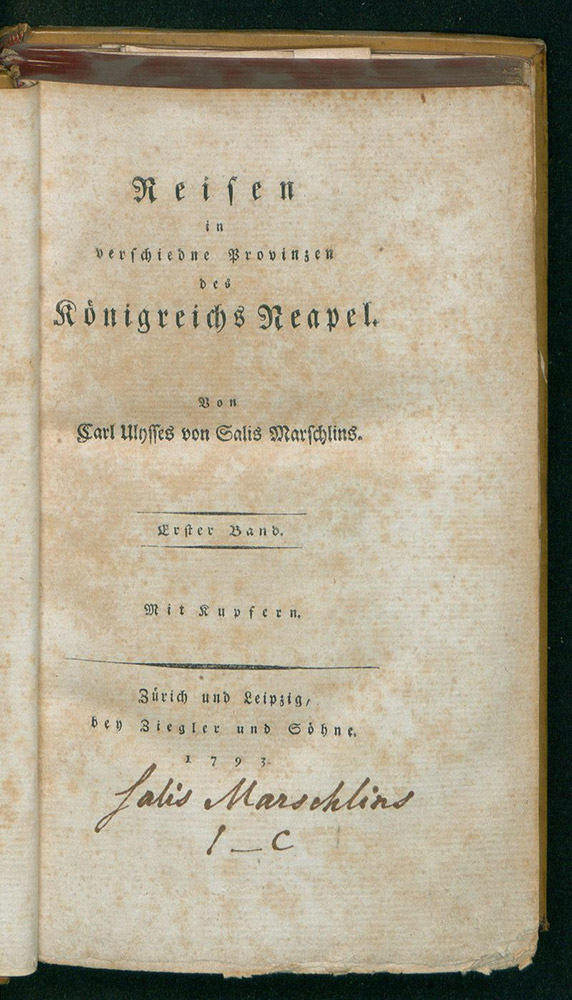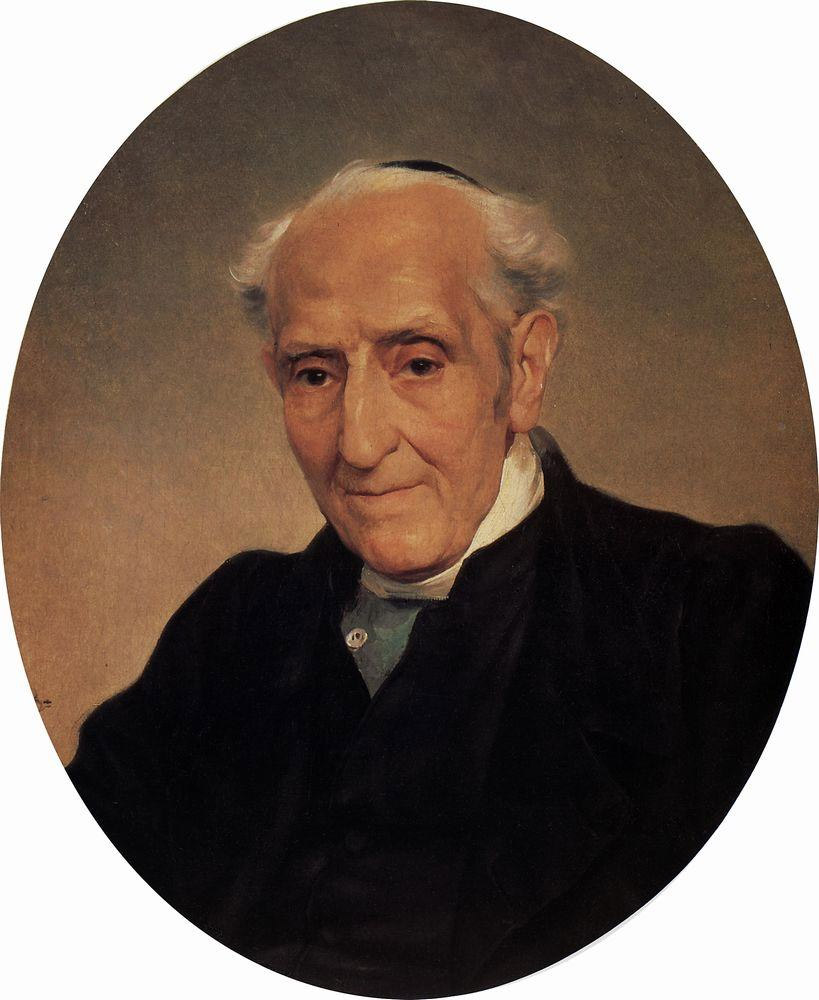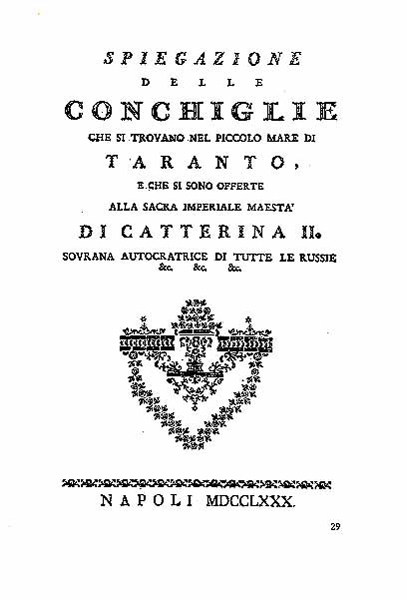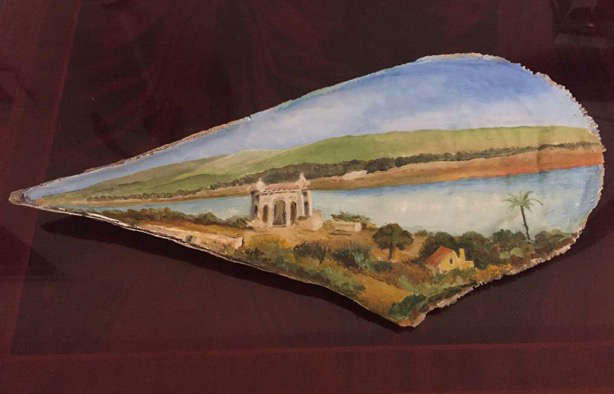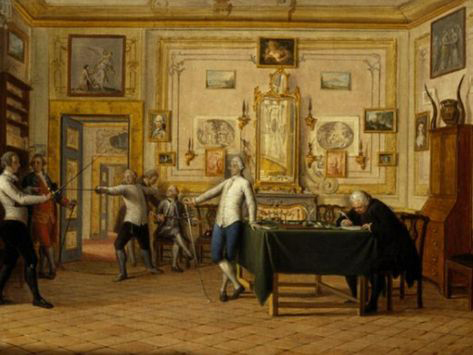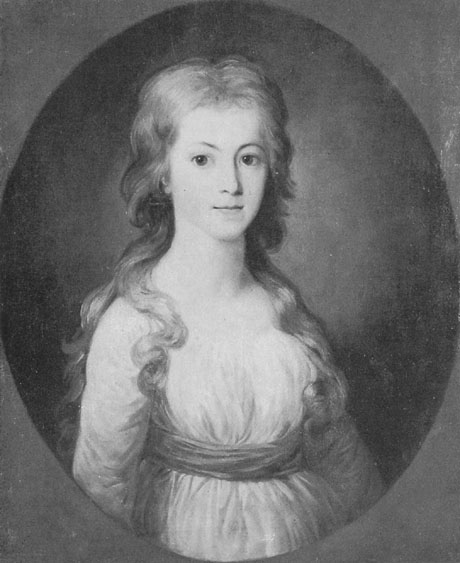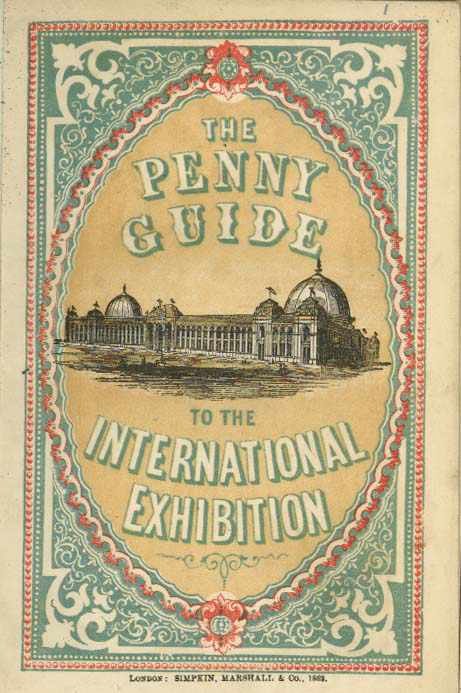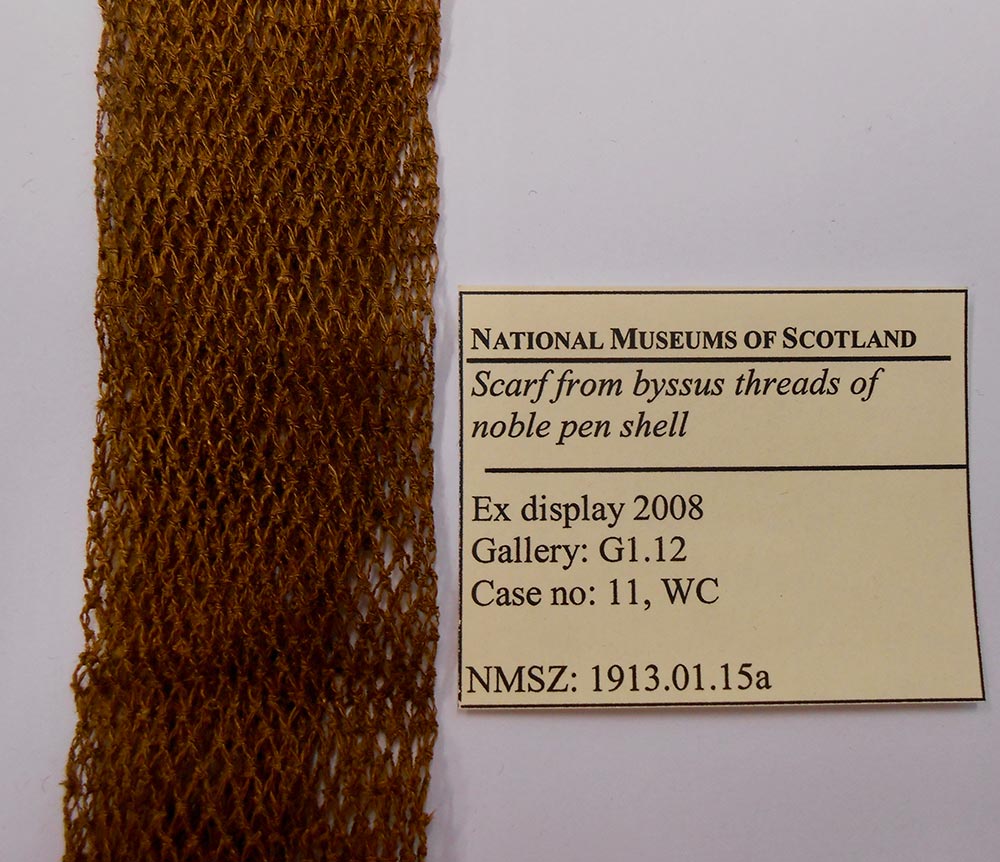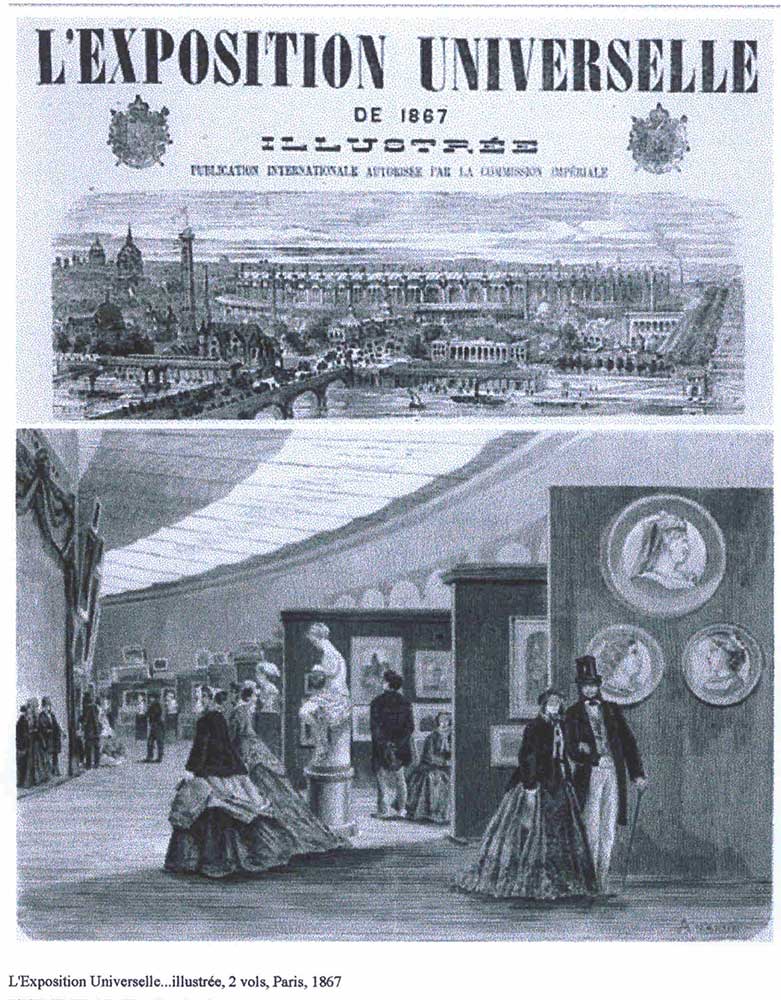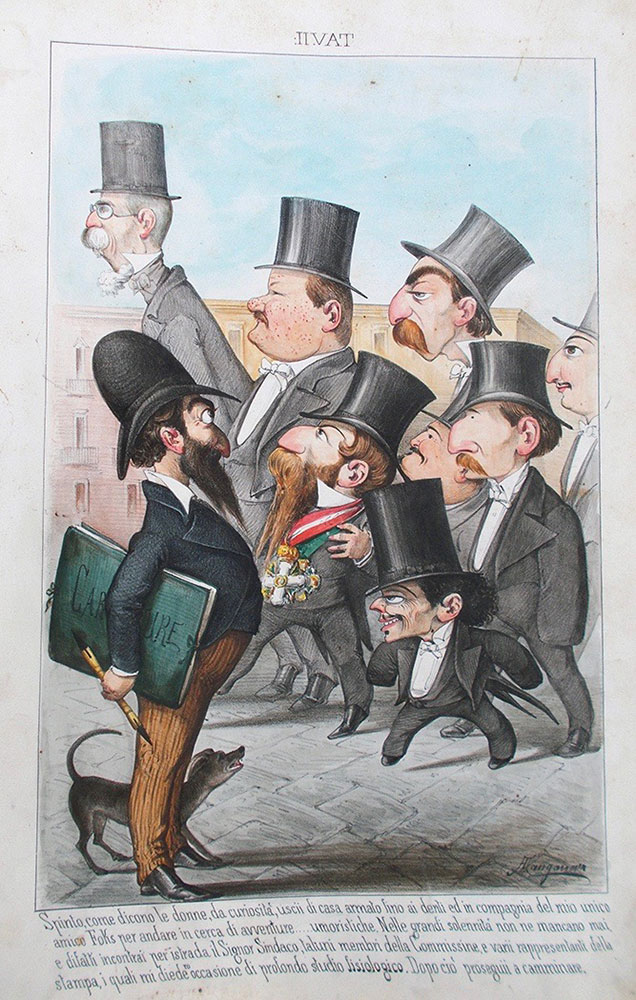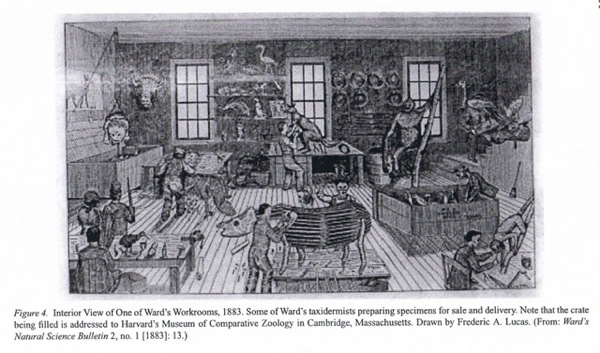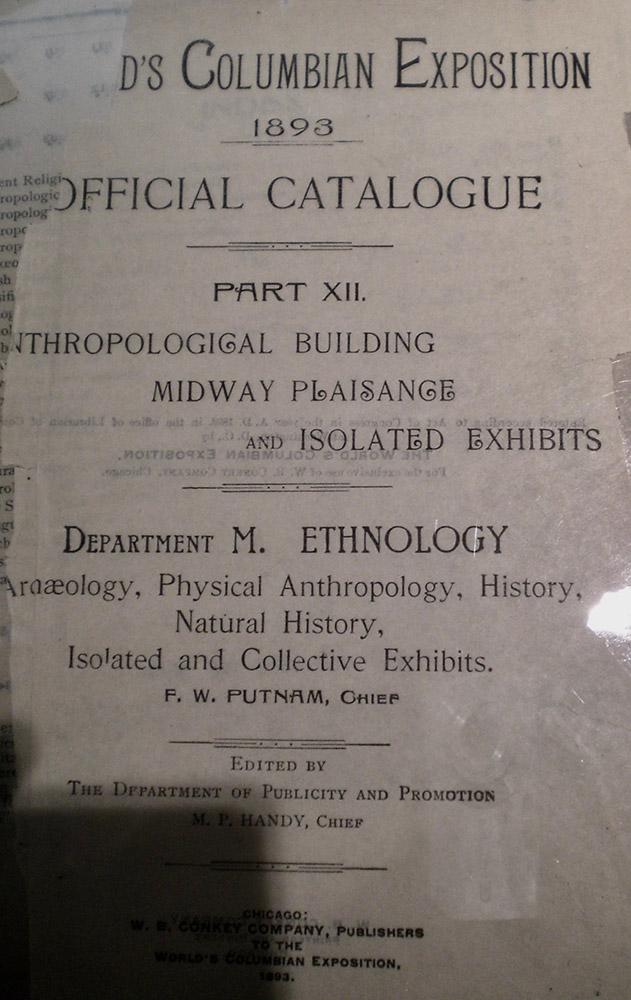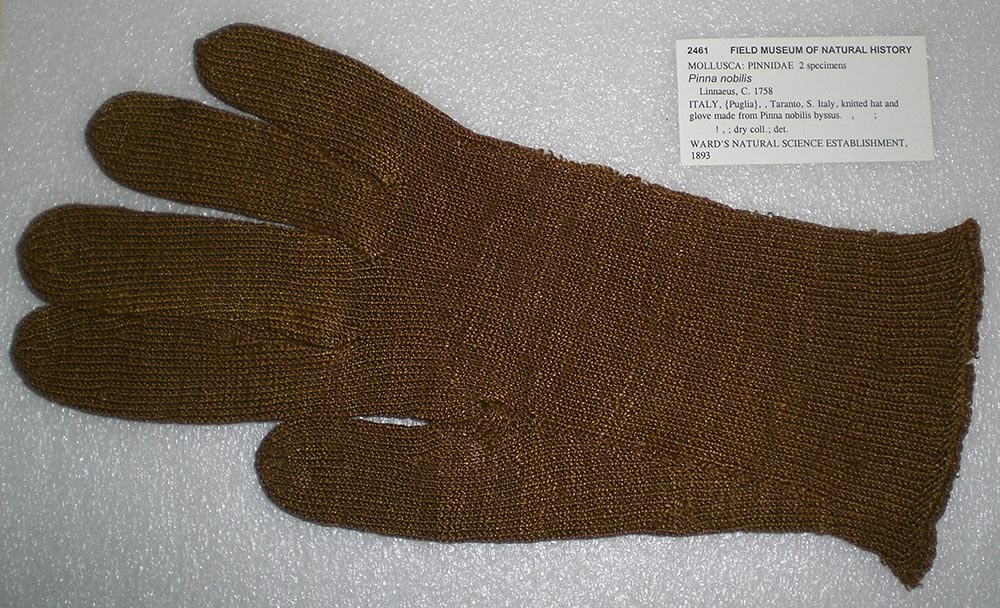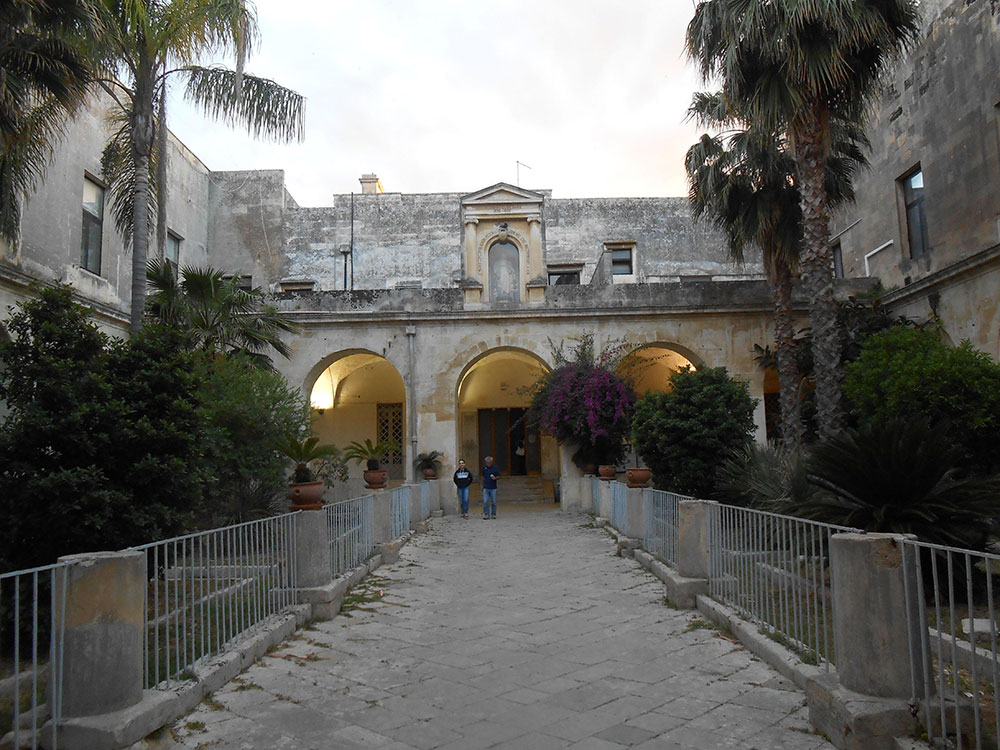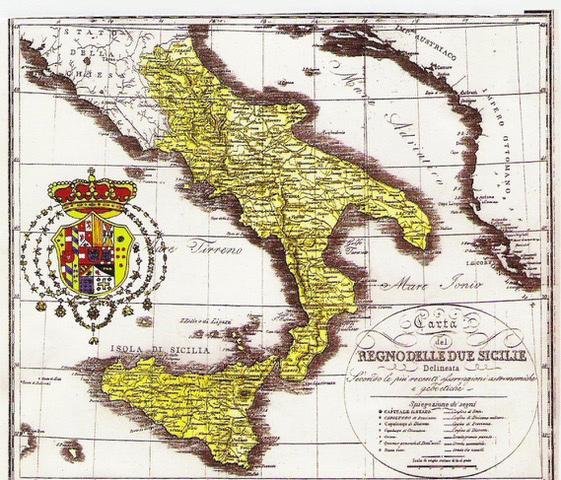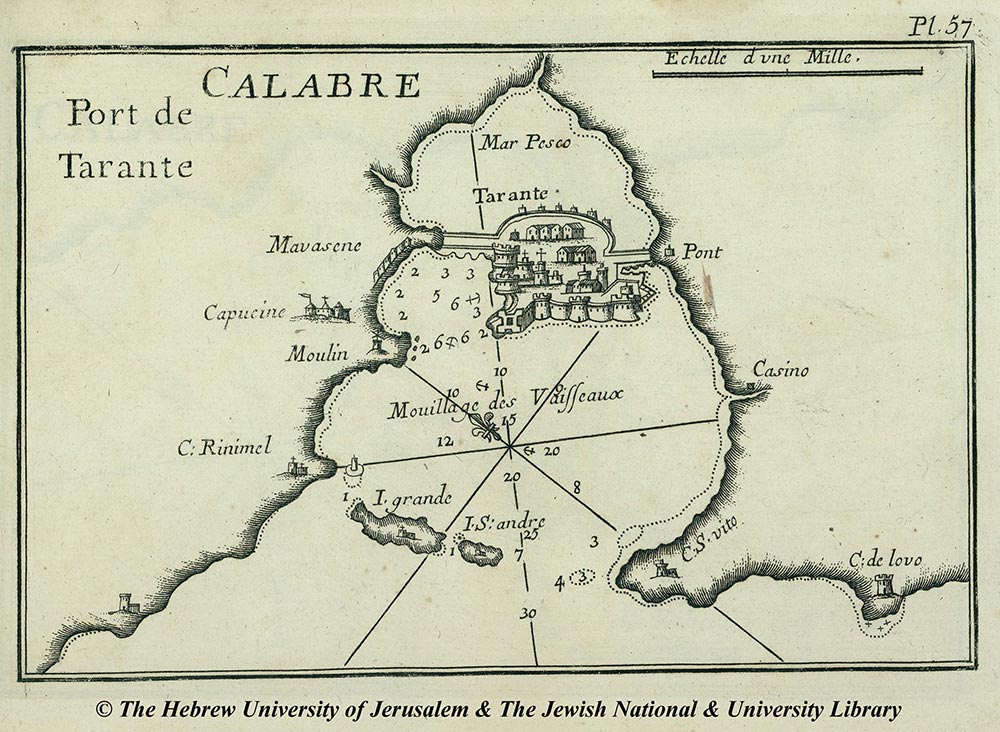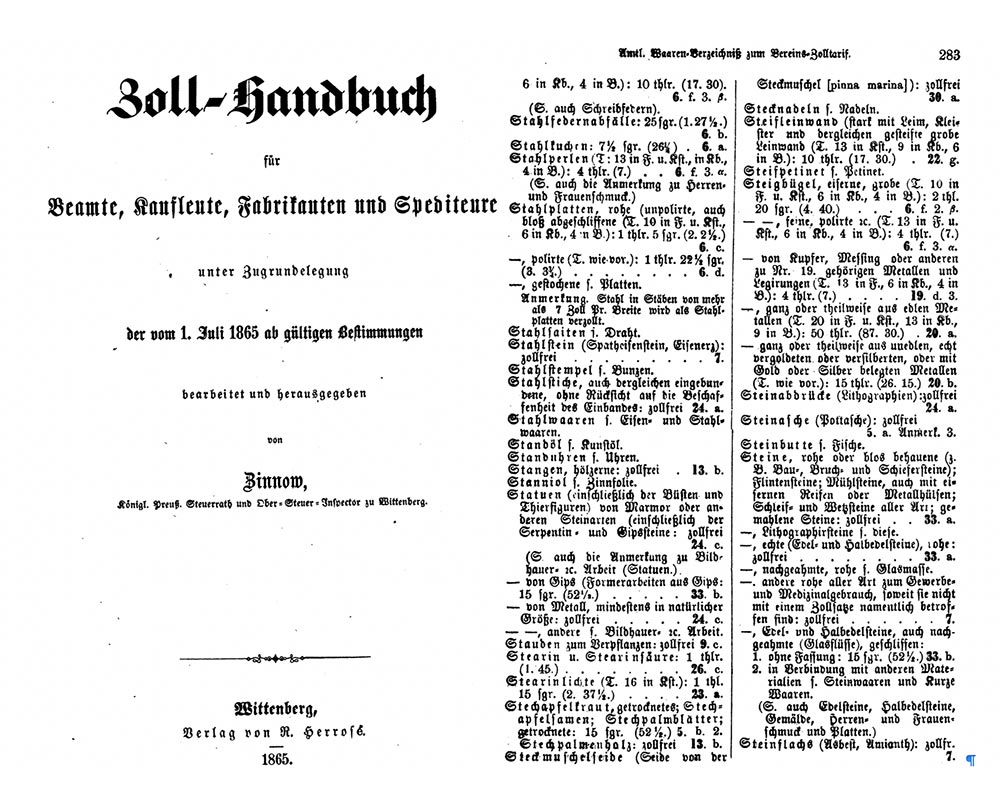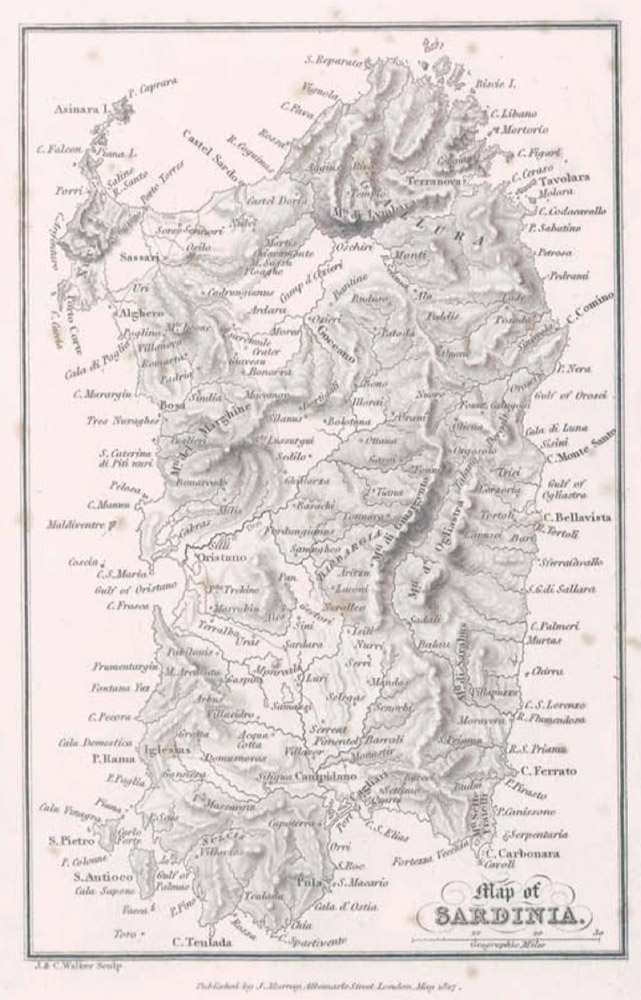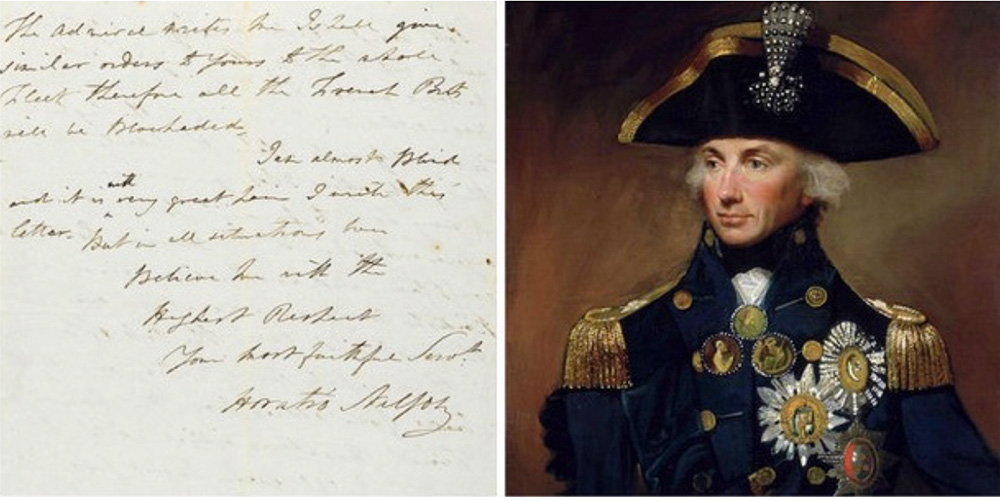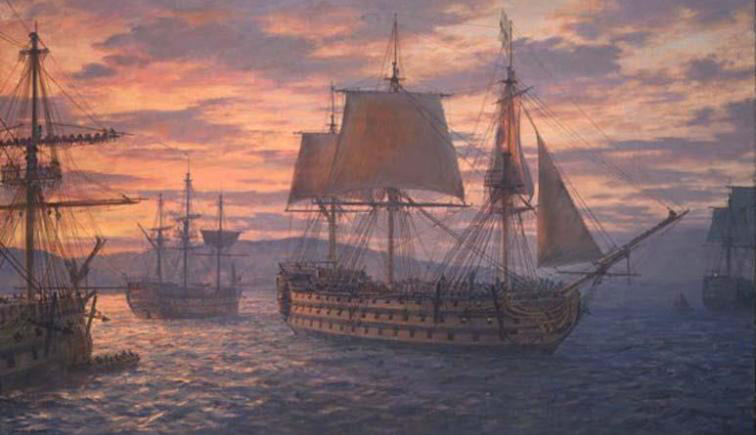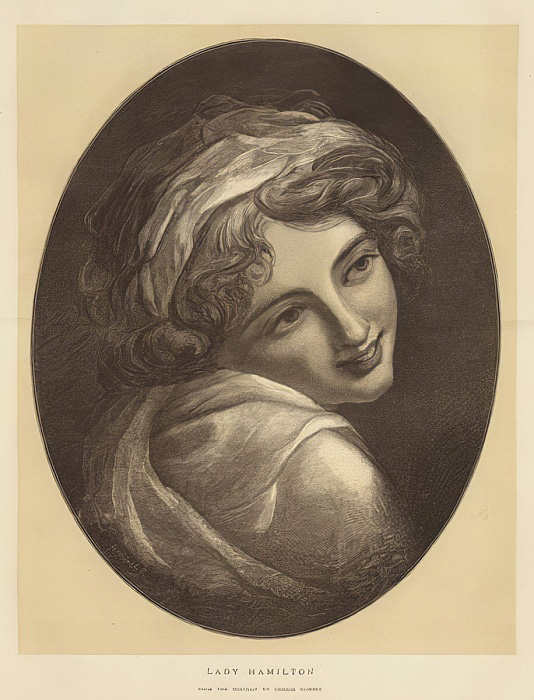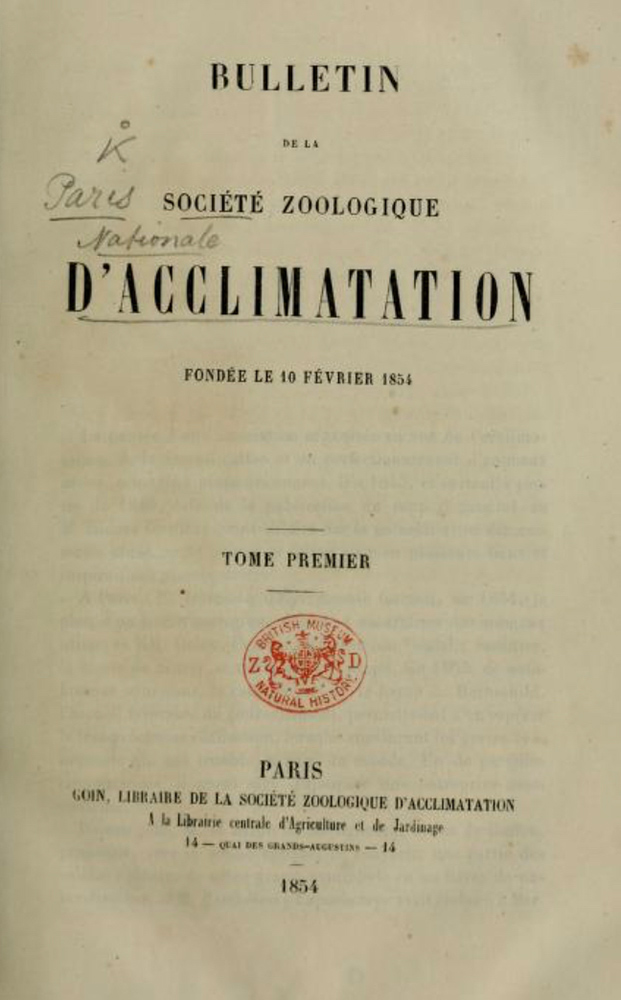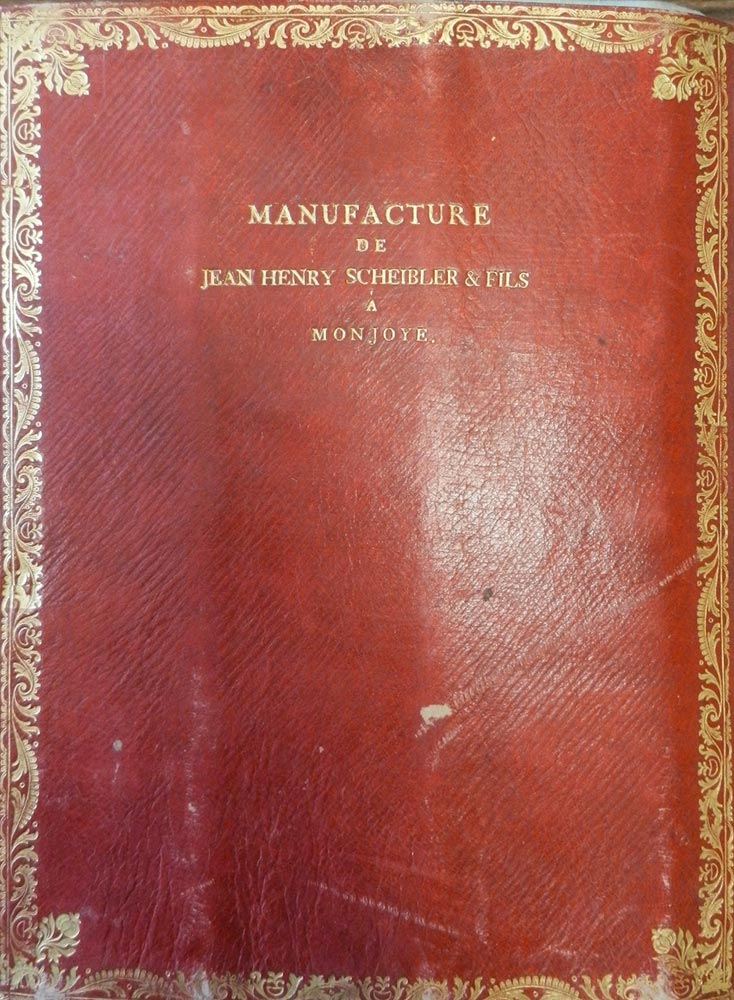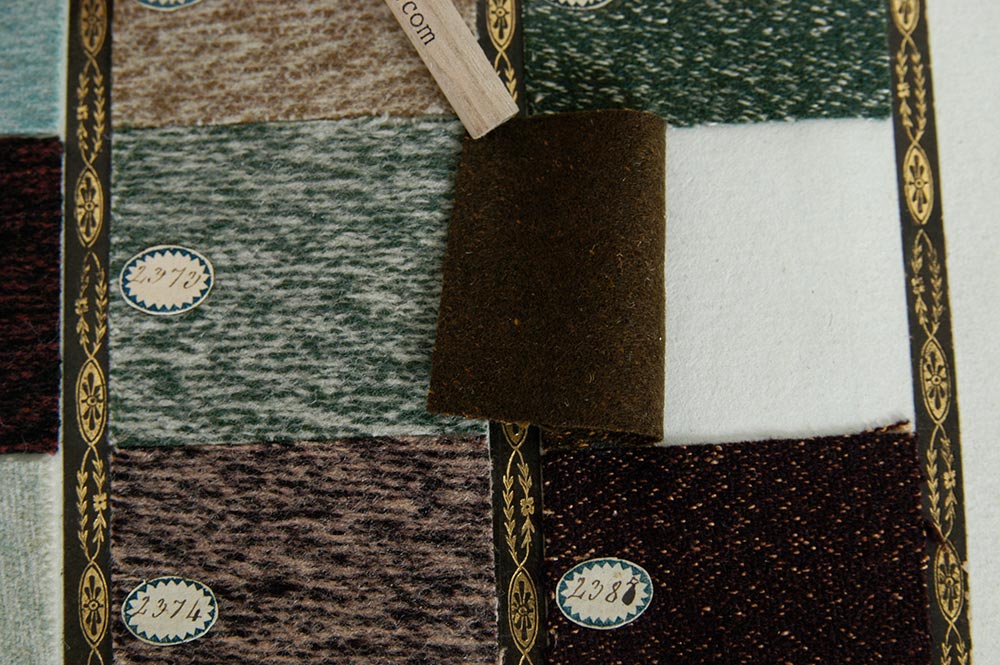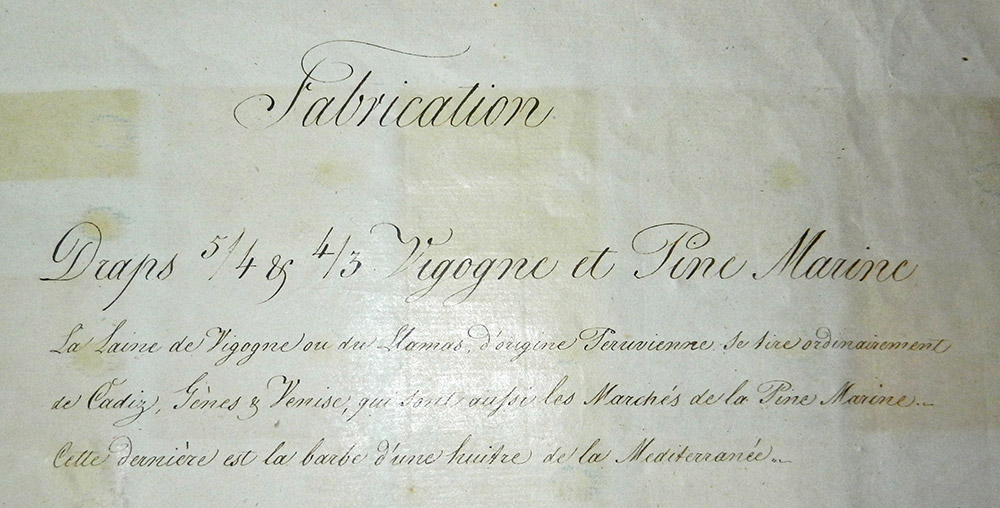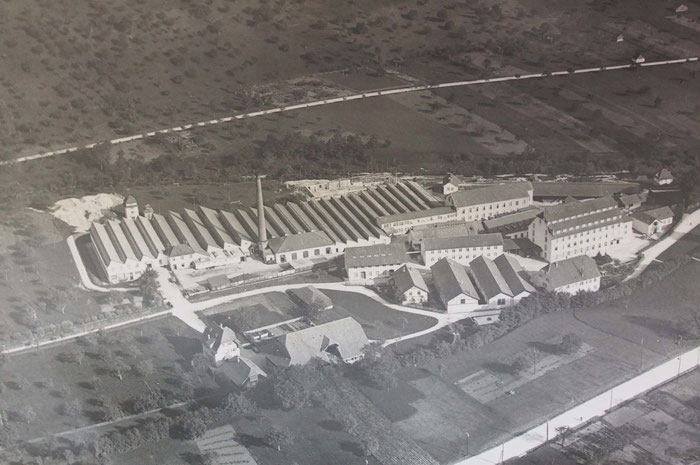Modern Times
In the late 15th and 16th centuries, the discovery of America and growing maritime trade brought new insights to natural sciences. The invention of letterpress printing contributed to the dissemination. As a marine product, the fibre beard of the fan shell (zoological term: byssus) found its way into the first printed and illustrated nature books together with its shell. Sometimes its use as a textile product is mentioned.
Most of the textile objects made from sea silk that still exist today found their way into the natural history museums through cabinets of curiosity; they are rarely found in textile collections.
News about sea silk can be found in many travel descriptions and diaries from young nobles on a grand tour. They are also gifts in aristocratic circles of church and state: “In kleinen Quanten genommen, diente die Muschelseide für die Herstellung von Neujahrsgeschenken der neapolitanischen Könige an die Schaaren kratzfüsselnder Höflinge.” (in English: New Year’s gifts from the Neapolitan kings to the flocks of scratchy courtiers) (Grothe 1873). Wealthy people now also undertake educational and study trips, report on them and often bring home objects of sea silk. Thereby the importance of the Archbishop of Taranto, Giuseppe Capecelatro, cannot be overestimated (see Historical Aspects → Modern Times → Giuseppe Capecelatro).
At the end of the 18th century, French and German textile companies experimented with sea silk without commercial success. Later, such textiles were almost exclusively mentioned as objects at various trade fairs and world exhibitions in Europe and the USA.
After 1900, Apulia and Sardinia experienced a brief revival of sea silk processing, but the Second World War put an end to it. Today, the Pinna nobilis is under protection and is even in great danger of being completely extinct (see Biological Aspects). A revival of the production is illusory. This makes it even more important to make efforts to preserve the knowledge of this cultural asset and pass it on to future generations.
Nature books
The invention of letterpress printing in the 15th century resulted in the first printed and illustrated books about plants and animals. Some contained descriptions and illustrations of shells and snails. This was the first time that knowledge about the fibre beard of the Pinna nobilis and the sea silk made from it became more widespread.
The first book dedicated exclusively to shells and snails was published in 1681, Ricreatione dell’occhio e della mente nell’osservation’ delle chiocciole. The book, written in Italian by Filippo Buonanni (1638-1725), is one of the first scientific books not written in Latin, but a Latin version appeared only three years later. Among Buonanni’s copperplate engravings, there are two fan shells with adhesive threads. The use of the byssus as textile material was known to him. He called it bisso marino, marine byssus, and contrasted it clearly with the bisso terrestre, the “rural” byssus, which is made of linen or cotton. Nearly 100 years later, the book was translated into German for an illustrated book on snails, with the beautiful title Vergnügen der Augen und des Gemüths, in Vorstellung einer allgemeinen Sammlung von Schnecken und Muscheln, welche im Meer gefunden werden (in English: Pleasure of the eyes and the mind, in presentation of a general collection of snails and shells found in the sea) (Knorr 1764).
In the 18th century, byssus became an object of natural history research. The French naturalist René-Antoine Ferchault de Réaumur (1683-1757), a member of the Académie Royale des Sciences in Paris, studied the various anchoring techniques of marine animals. He also described the Pinna nobilis and the fineness of its adhesive threads, and compared them with the coarse tow, a waste product of linen production: “…les fils sont par rapport à ceux des Moules ce qu’est le plus fin lin par rapport à l’étoupe.” One engraving shows a harvesting instrument and a fan shell with the byssus adhering to a stone. In 1742, the first book of seashells in French was published, the Conchyliologie by the scholar Antoine-Joseph Dezallier d’Argenville (1680-1765). The Pinna nobilis was widespread in Sicily, Sardinia and Corsica, he writes, and was used to make fabrics, stockings and gloves. The silk would be very similar to the byssus of the ancients. This shows that the product of the fan shell (sea silk) was also in France confused with the ancient linen byssus.
Friedrich Heinrich Wilhelm Martini (1729-1778) founded the Gesellschaft naturforschender Freunde zu Berlin in 1773. Alexander von Humboldt (1769-1859) was a member, and the society still exists today. Martini’s twelve-volume Conchylien-Cabinet, the first of which was published in 1769, was far ahead of its time in its scientific claim and became a standard in the field. After Martini’s death, Johann Hieronymus Chemnitz (1730-1800) continued his work. In the eighth volume, published in 1785, he dealt in detail with the different types of pinnae: “Jede Steckmuschel pfleget auf der einen Seite ihres schalichten Wohnhauses einen ziemlichen Büschel Seide hervorzustrecken, welcher Byssus genannt wird. … Zu Reggio, Tarent, Neapel, Messina und in mehreren Städten Italiens und Siziliens, giebt es sehr ansehnliche Fabriquen, darinnen diese Muschel Seide zu Strümpfen, Handschuhen, Westen, Beinkleidern u. dgl. verarbeitet wird.“ (in English: Every Pinna nobilis is sticking out a considerable tuft of silk on one side of its shell-like house, which is called a byssus. … In Reggio, Taranto, Naples, Messina and in several cities in Italy and Sicily, there are factories where this silk of a shell is made into stockings, gloves, waistcoats, trousers and the like.)
Chambers of curiosities and natural history collections
Chambers of curiosities, art and natural objects and cabinets of wonders or rarities are integral parts of the history of science, as their collections form the basis of almost all museums in Europe today (Fontes da Costa 2002). This is especially true for the museums of natural history. Exotic shells were early commercial and popular collectors’ items in the Netherlands, Germany, France, Denmark, England and Italy. Mussel and snail shells, grouped together as conchilia, belong to almost every collection. Not only are natural objects preserved and presented, but also products made from them. In addition to corals, pearls and other marine products, the fan shell, its beard and later also textile objects made of sea silk, found their way into natural history collections. The oldest evidence of this can be found in the diary of the Englishman John Evelyn (1620-1706), which describes a journey through Italy. On February 4, 1645, he visited the museum of the pharmacist and naturalist Ferrante Imperato (1550-1625) in Naples. This theatre of nature, as he calls it, is a great attraction for educated travelers. Evelyn writes: “Among the natural herbals most remarkable was the Byssus marina and Pinna marina” (Bray 1901).
In 1649 we find the first reference in France. The cabinet of a doctor in Castre, Languedoc, includes a Pinna and its byssus, ˮun peu de la soye de mer, qu’elle porte” (Borel 1649).
The 17th century Italian nobleman Ferdinando Cospi (1606-1686) was the owner of a cabinet in Bologna, which is immortalized on a detailed copperplate engraving. On the base of the exhibition furniture, we see several fan shells – without its byssus. In the catalogue of this cabinet the fibre beard is mentioned as “wool of the fan shell”, which imitates “the finest silk” (Legati 1677).
From all these examples, it is clear that the owners considered not only the shell but also its fibre beard to be worth collecting. But did they also know about the processing of the fibre beard into sea silk and its use as a textile?
In the 18th century this question was clarified, and we find the first use of the German term for sea silk, Muschelseide: “Die Steckmuscheln (pinnae), welche häufig in dem mittelländischen Meere um die Insel Malta, Corsica, Sardinien etc gefunden werden, ziehen aus ihrem Rüssel, wie die Spinnen, aus dem Hintersten zarte Fäden, woraus man in Tarento, Palermo etc allerley schöne Stoffe, Zeuge zu Kleidern, Camisölern, Mützen, Strümpfe, Handschuhe verfertigt. Die natürliche Farbe dieser Muschelseide fällt ins Olivengrüne, ist aber nicht so weich und fein, als die ordentliche Seide. In Sammlungen hat man öfters Gelegenheit, dergleichen gearbeitete Sachen zu sehen.“ (Rudolph 1766), (in English: “The pinnae, which are often found in the Mediterranean sea around the island of Malta, Corsica, Sardinia, etc., draw delicate threads from their trunks, like spiders from the back of their necks, which are used in Tarento, Palermo, etc. to make all sorts of beautiful fabrics, dresses, shirts, caps, stockings, gloves. The natural colour of this sea silk falls into the olive green, but is not as soft and fine as the ordinary silk. In collections one often has the opportunity to see such things.”
Hans Sloane (1660-1753), the founder of the British Museum in London, is considered the last universal collector. The collection he catalogued himself between 1702 and 1747 contained almost 6,000 shells, and in addition to corals and sponges there are gloves made of sea silk: ”A pair of men’s glove made of the beard of the pinna marina in Andalousia in Spaine sent me by His Grace the Duke of Richmond.” These gloves are later described as “one of the most curious items connected with the invertebrate exhibits” (Way 1994). Van Rymsdyk’s catalogue Museum Britannicum from 1778 shows one of these gloves which still exists (link: Inv.Nr. 15). In the Sloane catalogue, there is another single glove made of sea silk, also a gift from the Duke of Richmond. Both objects are believed to have originally come from the collection of Martin Lister (1639-1712), author of Historiae Conchyliorum (1685-1692) and Conchyliorum Bivalvium (1696). After Sloane’s death in 1753, his entire collection, including the objects made of sea silk, was purchased by the English state for the new British Museum. A 12-year-old boy tells of his visit to the newly founded museum: ”Der nächste Raum war mit allerlei Schlangen und Eidechsen gefüllt… Es gab dort auch ein Paar Handschuhe, die aus den Bärten von Muscheln gemacht worden waren“ (in English: The next room was filled with all kinds of snakes and lizards… There was also a pair of gloves made from the beards of mussels.) (Blom 2004) Sloane’s collection forms the core of the current mollusk collection of the Natural History Museum in London, which still includes several textile objects made from sea silk. (link: Inv.Nr. 14, 15, 16, 17).
Don Pedro Francisco Davila (1710-1775), a Peruvian living in Paris, had to sell his extensive natural history collection in 1767. In order to increase the financial success of the auction, he published a three-volume “systematischen und durchdachten Katalog der Kuriositäten der Natur und der Kunst” (in English: a systematic and well thought-out catalogue of curiosities of nature and art). Among the shells in his collection are a Pinne-marine as well as gloves and stockings made of sea silk from a Neapolitan manufacturer: “On a joint à cette Coquille une paire de bas & une paire de gands de Byssus, qui ne cèdent rien à ceux de soie pour la finesse & la beauté. Ils viennent de la Manufacture de Naples.”
Also, the German naturalist Johann Hieronymus Chemnitz (1730-1800) owned “ein paar Strümpfe von solcher in Italien gewebten Muschelseide, welche an Schönheit und Feinheit den besten seidenen wenig nachgeben, und mit ihrem spielenden unnachahmlichen Goldglanze sie noch übertreffen” (Hauber 1782), (in English: a pair of stockings of such sea silk woven in Italy, which in beauty and delicacy yield little to the best silk ones, and with their playing inimitable golden luster even surpass them) in his Conchylienkabinett in Vienna.
In Strasbourg’s Musée zoologique, elbow cuffs are exhibited in a showcase, together with a Pinna nobilis and several fiber beards glued together. They were the gift of a Sicilian student, M. Ribasse, to his teacher, the Strasbourg doctor and university professor Jean Hermann (1738-1800). His collection was later integrated into the museum founded in 1893.
The Naturhistorische Museum Braunschweig, in Germany, also originated from a princely collection. In 1754, Charles I Duke of Brunswick and Lüneburg (1713-1780) established the Herzogliche Kunst- und Naturalienkabinett in the Dankwarderobe Castle. In the inventory of 1857, a pair of stockings is listed, “so von der bey allen Steckmuscheln sich findenden Seide, bissus genannt, verfertiget sind” (in English: … as made from silk, called bissus, which is found in all fan shells). For a long time, they were the only known stockings made of sea silk, but another pair has now been identified in the Bavarian National Museum in Munich.
Gustav Friedrich Klemm (1802-1867), cultural historian and librarian in Dresden, described a cultural-historical collection in 1850. Its purpose was “die Entstehung und den Fortschritt der verschiedenen menschlichen Gewerbs- und Kunsterzeuge aus den von der Natur im Stein-, Pflanzen- und Thierreiche dargebotenen Stoffen und Gestalten durch Thatsachen und Körper nachzuweisen” (in English: to prove the origin and progress of the various human industrial and artistic products made from the materials and forms offered by nature in the stone, plant and animal kingdoms). This also included a “collection of gloves made of rare materials, such as sea silk.” His collection forms the basis of the later Museum für Völkerkunde in Leipzig.
Grand Tour and educational tours
Travel guides, travel reports and diaries are important sources in the history of sea silk. From the 17th century, Italy was not only the obligatory destination of young noblemen on Grand Tour, but it also became the obligatory destination for educational tours taken a new class of bourgeois interested in science. The southernmost terminus on the mainland was usually Naples. However, the few who visited Taranto, the former capital of ancient Greece, almost always reported on sea silk.
One purpose of traveling at that time was to gather new knowledge about cultures and to later convey this knowledge. Therefore, the study of natural history guides was one of the many preparations for the trip. The Italian Alberto Fortis (1741-1803) published in 1771 a travel guide for the Dalmatin coast: Informations préliminaires, que l’on croit nécessaires pour servir de direction à des voyages tendant à illustrer l’histoire naturelle, where he asked: “récolte-t-on de la soie de la Pinne marine, appelée vulgairement astura (jambonneau), comme on le fait en Istrie? ” (in English: Is silk from the Pinne marine, vulgarly called astura, harvested there as it is done in Istria?). He had travelled to Dalmatia and learned about the processing of sea silk (Fortis 1778). Still in the 19th century we read: “Ehemals wurde dieses Material nach Neapel verkauft, jetzt wird es in Dalmatien selbst verarbeitet” (in English: In former times this material was sold to Naples, now it is processed in Dalmatia itself.) (Blumenbach 1846). Unfortunately, no further written or material evidence has been found in Croatia to date.
In addition, in a 19th century manual for travelers, reference is made to the sea silk: “ausserdem wird hier noch eine Muschel gefunden, Pina marina genannt, welche einen Büschel feiner Haare oder Fasern von glänzender grüner Farbe enthält die gesponnen und zu Handschuhe, Strümpfen u.s.w. verarbeitet werden” (Neigebaur 1826), (in English: a shell is found here, called pina marina, which contains a tuft of fine hairs or fibers of shiny green color, which are spun and made into gloves, stockings, etc.)
The Danish polymath and tireless traveler Nicolaus Steno (1638-1686) stayed in Italy from autumn 1668 to spring 1669. In his report, he mentions a Seesteckmuschel (fan shell) and its byssus, but not its processing into sea silk (Stensen 1669).
In 1740, the German polymath and travel writer Johann Georg Keyssler (1693- 1743) published a book about his many travels. Among the Merkwürdigkeiten des Königreichs Neapolis is the sea silk: “Einer sonderbaren Fabrike muss ich hiebey gedenken, welche vornehmlich zu Tarento und Reggio im Schwang ist, und wozu die Fäserchen oder eine Art von Haaren und Wolle, die an einer gewissen Sorte von Muscheln gefunden wird, Gelegenheit geben. Den diese hat man also zu reinigen und zu bereiten gelernet, dass anitzt Camisoler [Westen], Mützen, Strümpfe und Handschuhe, welche wärmer als Wolle halten, daraus gestricket und verfertiget werden. An der Weiche und Feinigkeit kommen solche der Seide nicht bey; hingegen behalten sie stets einen sonderbaren Glanz. Die natürliche Farbe dieser Muschelwolle fällt in das Olivengrüne…” (Keyssler 1741), (in English: I have to commemorate a strange factory, mainly in Tarento and Reggio, and which … a kind of hair and wool found on a certain kind of mussels …. has been learned to clean and prepare waistcoats, caps, stockings and gloves, which keep warmer than wool …. The softness and delicacy are not matched by those of silk, but they always retain a peculiar sheen. The natural color of this mollusk wool falls into the olive green…)
Johann Hermann Riedesel, Baron of Eisenbach (1740-1785) was an envoy of Frederick II in the Viennese court. His book Reise durch Sicilien und Grossgriechenland (1771) (Travels through Sicily and that part of Italy formerly called Magna Grecia, 1773) was a great success. We know that it served Goethe as a travel guide through southern Italy. Riedesel arrived in Taranto on May 20, 1767, and there he got to know the wool of the pinna: “Diese Lana Penna, welche wohl einen halben Palm lang ist, wird a Capo St. Vito, der mittägigen Spitze des Tarentinischen Hafens, häufig gesichtet: Unerachtet ihrer Grösse giebt sie sehr wenig von der Seide, aus welcher Strümpfe, Handschuhe, und verschiedene Kleidungen gestrickt werden; und von einem Pfund dieser rohen Wolle bleiben nur 3 Unzen, nachdem sie bereitet worden, wozu 40-50 Muscheln erfordert werden: Die Fischer verkaufen diese rohe Wolle, das Pfund 12-16 Carlini, und ein paar Handschuhe wird um 30, ein paar Strümpfe aber um 100 – 120 Neapol. Carlini, oder 10-20 Ducati, verkauft: Die Bereitung davon ist sehr mühsam und künstlich; man kan nichts als die Spizen davon gebrauchen, und die andere Helfte wird weggeworfen; sie wird unzählige Male in kaltem Wasser gewaschen und an der Luft getrocknet, bis sie von allen Unreinigkeiten gesäubert worden; muß alsdann auf einem feinen Kammbrete von Drat gekämmt, und endlich mit kleinen Spindeln gesponnen und gestrickt werden. Viele vermischen sie mit ein wenig Seide, damit sie mehr Festigkeit bekomme, wodurch sie aber die Gelindigkeit und Wärme verliert” (Riedesel 1771), (in English: This Lana Penna, which is probably half a palm long, is frequently seen at Capo St. Vito, the midday peak of the Taranto harbor: Regardless of its size, it gives very little of the silk from which stockings, gloves, and various garments are knitted; and of a pound of this raw wool only 3 ounces remain after it has been prepared, which requires 40-50 shells: The fishermen sell this raw wool, the pound 12-16 Carlini, and a pair of gloves is sold at 30, but a pair of stockings at 100-120 Naples. Carlini, or 10-20 Ducati. The preparation of it is very laborious and artificial; one can use nothing but the spikes of it, and the other half is thrown away; it is washed innumerable times in cold water and air-dried until it is cleaned of all impurities; then it must be combed on a fine comb, and finally spun and knitted with small spindles. Many mix it with a little silk to make it stronger, but it loses its softness and warmth.)
The French painter and engraver Jean-Claude Richard de Saint-Non (1727-1791) published a five-volume work on his journey to Italy in the 1780s. In Taranto he spoke to fishermen who sold a pound of fibre beards at 18 carlins; a high price that only the richest could pay: “On nous dit … qu’ils n’y avoit que les Gens le plus opulens en état d’acquérir une marchandise aussi coûteuse” (Saint-Non 1783).
The English travel writer Henry Swinburne (1743-1803) undertook several trips to Italy with his wife between 1777 and 1780. His travelogue appeared in 1783 and was translated into French and German only two years later. In Taranto, Swinburne spent an afternoon with a fisherman on the Mar piccolo and the Mar grande. There, he had all the shells and snails shown to him and their production and use explained. Here he also got to know sea silk: “Under Cape St. Vito, once famous for an abbey of Basilian monks, and in most parts of the Mare Grande, the rocks are studded with the Pinna Marina. This bivalve shell of the muscle tribe frequently exceeds two feet in length. It fastens itself to the stones by its hinge, and throws out a large tuft of silky threads, which float and play about to allure small fish … The Pinna is torn off the rocks with hooks, and broken for the sake of its bunch of silk called Lanapenna, which is sold, in its rude state, for about fifteen carlins a pound, to women that wash it well with soap and fresh water. When it is perfectly cleansed of all its impurities, they dry it in the shade, straiten it with a large comb, cut off the useless root, and card the remainder; by which means they reduce a pound of coarse filaments to about three ounces of fine thread. This they knit into stockings, gloves, caps, and waistcoats; but they commonly mix a little silk as a strengthener. This web is of a beautiful yellow-brown, resembling the burnished gold on the back of some flies and beetles. I was told that the Lanapenna receives its gloss from being steeped in lemon juice, and being afterwards pressed down with a taylor’s goose.” (Swinburne 1785)
The most detailed description of the extraction and processing of sea silk comes from the Swiss natural scientist Carl Ulysses von Salis Marschlins (1760-1818). His report on his travels to various provinces of the Kingdom of Naples, published in 1793, was later translated into English and Italian. “Although every part of the Neapolitan sea produces this shell-fish in great abundance, and of an extraordinary size, the Tarentines alone reap any advantage from it, and even collect it upon the coasts of Sardinia and Corsica; but the tuft of silk, for which they are sought and collected, is not equally good in all places. Where the bottom of the sea is sandy, the shell and its tuft, which takes root in the sand, may easily be drawn out; and when washed, the tuft is of a glossy gold color. In rushy and muddy bottoms the shell and tuft not only stick so fast as to be generally broken when drawn up, but the color of the silk is black, and without gloss. The shell is always in an upright position, open, and half a palm deep in the ground. … As soon as a pinna is discovered, the iron is slowly let down to the ground over the shell, which is then twisted round, and drawn out. When the fishermen has got a sufficient number of them, the shell is opened, and the silk, called at Taranto lana penna, is cut off the animal, and after being twice washed in tepid water, once in soap and water, and twice again in tepid water, is spread upon a table, and suffered to half dry in some cool and shady place. Whilst it is yet moist, it is softly rubbed and separated with the hand, and again spread upon the table to dry; and when thoroughly dry, it is drawn through a wide comb, and afterwards through a narrow one. Both these combs are of bone, and, except in size, are like hair combs. The silk thus combed belongs to the common sort, and is called extra dente; but that which is destined for finer works is again drawn through iron combs, or cards, there called scarde. It is then spun with a distaff and spindle, two or three threads of it being mixed with one of real silk; after which they knit not only gloves, stockings, and waistcoats, but even whole garments of it. When the piece is finished, it is washed in clean water, mixed with lemon juice; after which it is gently beaten between the hands, and finally smoothed with a warm iron. The most beautiful are of a brown cinnamon and glossy gold color, producing a very rich and pleasing effect. As everything made of this sort of silk is very subject to be moth-eaten, care must be taken to keep it from all eatables and sweetmeats, and to wrap it in clean linen. A pair of women’s gloves costs upon the spot sixteen carlini (six shillings) and a pair of stockings costs from three to four ducats (from 11s. 3d. to 15s.) and so in proportion; but the sale of this manufacture is not very extensive.” (von Salis Marschlins 1795) He was not only a precise observer, but also a critical researcher who knew the linguistic inconsistencies about the term byssus.
Giuseppe Capecelatro, Archbishop of Taranto
Taranto 1778 – 1799. We owe most of the objects made of sea silk that still exist today to this man. Giuseppe Capecelatro (also Capece-Latro) (1744-1836) was an extraordinary personality of old Neapolitan nobility. He was a highly educated lawyer and man of the Enlightenment. His rebellious writings on the renewal of the Church, including the abolition of celibacy, were immediately banned by the Vatican. He has swapped a career in the church for service to his community. Swinburne wrote in 1783 about the difficult economic situation of Taranto, but also saw hope in Capecelatro, who was extremely sensitive to the misery of the lowest classes: “…but there is great reason to hope these inconveniencies will be removed by the patriotic and judicious endeavors of the present Archbishop Monsignor Joseph Capecelatro, who has abandoned the road that leads to the purple, and other objects of ecclesiastical ambition, in order to devote his life and talents to the welfare of his flock, and the improvement of his native country.” (Swinburne 1783)
At a time when the nobility enjoyed and the people paid, the Archbishop of Taranto promoted all the employment opportunities offered by the rich fishing grounds off Taranto’s coasts. The Pinna nobilis was one of them. The processing of turning the adhesive threads into sea silk and its further processing into textile objects was intended to improve the living situation of the people. He himself took over the dissemination of the knowledge and the distribution of the objects through his extensive network of correspondents. Marketing avant la lettre.
In 1780, only two years after his election as Archbishop of Taranto, due to his interest in natural science he published a paper on the mussels and snails in the Mar piccolo: Spiegazione delle conchiglie che si trovano nel piccolo mare di Taranto. It was dedicated to the Russian Tsarina Catherine II, and the Taranto musician Giovanni Paisiello (1740-1816), who was the conductor at the court of Saint Petersburg at the time, acted as intermediary. Together with several fan shells and gloves, the knowledge of sea silk thus reached the Russian court. It was to have a lasting effect, as in the following dozens and dozens of sea silk objects found their way to St. Petersburg and to his many friends all over Europe (Sada 1983). Unfortunately, none of these objects could be found until today.
Friedrich Leopold Graf zu Stolberg (1750-1819), a lawyer and writer in Berlin, was a guest of Archbishop Capecelatro in Taranto in May 1792, which he reports on in detail in his diary. “A margine, simpatico e significativo è l’episodio ricordato da Stolberg: la donna invitata dal Capecelatro per spiegargli tutti i passaggi della lavorazione, si inorgoglisce e si commuove per l’interesse e gli apprezzamenti manifestati dallo straniero. Il giorno dopo Stolberg con sorpresa, riceve in dono dalla donna un paio di guanti, segno tangibile della sua riconoscenza. Sebbene di umili origini e forse analfabeta, la sconosciuta tarantina ha dato prova di grande dignità e garbo tanto da colpire la sensibilità di Stolberg il quale ha avvertito la necessità di tramandarci l’episodio.” (Girelli Renzulli 2000) (In English: …nice and significant is the episode mentioned by Stolberg: the woman invited by Capecelatro to explain all the steps of the work, is proud and moved by the interest and appreciation shown by the foreigner. The next day Stolberg is surprised to receive a pair of gloves as a gift from the woman, a tangible sign of her gratitude. Although of humble origins and perhaps illiterate, the unknown Tarantine woman showed great dignity and courtesy so much that she struck Stolberg’s sensibility that he felt the need to pass the episode on to us.)
The mentioned gloves (link MS-Inventory 1) today belong to the Zoological Collection of the University of Rostock.
In 1797 Ferdinando IV, King of Naples, visited Taranto accompanied by Queen Maria Carolina, daughter of Maria Theresa of Austria. They stayed at the archbishop’s country residence, the Villa Lucia, overlooking the Mar piccolo. He also gave them alcuni berrettini di bisso, caps made of sea silk (Vacca 1966).
In 1799, in the troubles at the end of the French Revolution, Capecelatro was arrested, taken to Naples and sentenced to ten years in prison. Probably through the mediation of the afore mentioned Queen Maria Carolina, he was released in 1801. He then took up residence in Naples and never returned to Taranto.
Naples 1800-1836. Capecelatro lived on the second floor of the Palazzo Sessa, which had been occupied before him by the English ambassador Sir William Hamilton and his wife Emma. Capecelatro and Hamilton had already met in Taranto. Emma Hamilton had been presented with gloves made of sea silk by her later lover, Admiral Horatio Nelson. On March 18, 1804, he wrote to Emma on board the Victory: “I send you the comb… and a pair of curious gloves, they are made only in Sardinia of the beards of mussels. I have ordered a muff, they tell me they are very scarce, and for that reason I wish you to have them.”She likely got these gloves, but where are they today? He wrote again on August 20, 1804: “I have not yet received your muff; I think, probably, I shall bring it with me” (Nelson 1814). See more in the chapter Inventory → Potential objects.
In Capecelatro’s correspondence with his vicar Antonio Tanza (1740-1811), who had assumed episcopal duties in Taranto, we find several orders for objects made of sea silk. There was an order in 1802 for a waistcoat and socks, una camisciola di lanapinna ed un paio di calzette dell’istesso genere for a marchese Taccone, in 1804 for four pairs of men’s and two pairs of women’s gloves di lanapesce as well as twelve caps, berrettini sfioccati (fur-like processed?), and in 1805 for six men’s and four women’s gloves di lanapinna (the size was enclosed as a paper pattern) as well as twelve pairs of men’s gloves and six pairs of long women’s gloves di lanapinna travagliati con qualche maggiore delicatezza. These were to be made with the greatest care, as they were intended for the court of Saint Petersburg (Vacca 1966).
Wilhelm von Humboldt (1767-1835) was the Prussian resident at the papal chair in Rome from 1802 to 1808. In his correspondence with Carl August von Struensee (1735-1804), Prussian minister of finance, we find several mentions of sea silk. On February 18, 1803, he answered Struensee’s request to send a copy of the Pinna marina: “…und der Pinna marina werde ich mir alle mögliche Mühe geben, und wenn Er mir nur ein Paar Monate Zeit lassen wollen, hoff ich Ihre Befehle genau erfüllen zu können” (in English: …and for the Pinna marina I will do my utmost, and if He will only give me a few months, I hope to be able to fulfil your orders exactly). On March 12, 1803, he writes, “Pinna marina aus Neapel angefordert“ on the same subject (von Humboldt 1968). On Christmas Day 1803 he reports on his efforts to obtain Pinna marina wool, and on March 31, 1804, a consignment of 3 pounds of Pinna marina is mentioned, which is an astonishing amount. It can be assumed that Capecelatro was his contact in Naples, as he was in correspondence with him.
In 1808, Capecelatro became Minister of the Interior under Gioacchino Murat, King of Naples from 1808-1815 and Napoleon’s brother-in-law. “Il più amabile di tutti i verscovi e arcivescovi,” as he was called by one admirer, was a gifted host and networker. The Swedish King Gustav III wrote about him: “Lorsqu’on vient à Naples, il faut y voir Pompei, le Vésuve, et l’archevêque de Tarente.” (In English: When you come to Naples, you must see Pompeii, Vesuvius, and the Archbishop of Taranto.) He Capecelatro corresponded with almost all of the known scholars and writers of his time: Goethe, Herder, Kotzebue, Germaine de Staël, Alexander von Humboldt, Lamartine, Walter Scott, Ludwig I of Bavaria and many others. In addition, he had a deep friendship with Anna Amalia of Weimar (1739-1807). It can be assumed that there is information about sea silk in the corresponding letter archives, a treasure that has yet to be lifted.
The German philologist and librarian Johann Simon Karl Morgenstern (1770-1852) visited Naples and Capecelatro in 1808. “Er fand hier die bekannte würdige Frau Etatsräthin Brun mit ihrer Tochter. …. Beym Abschiede schenkte der Erzbischof der Mad. Brun und Ida meergrüne Handschuhe, die aus den Fasern einer bey Tarent haufigen Seemuschel (pinna marina) gearbeitet werden.” Again, there was a gift of sea-green gloves for Mrs. Brun and her daughter Ida (Morgenstern 1813).
The German Baroness Elisa von der Recke (1754-1833) published a “Tagebuch einer Reise durch einen Theil Deutschlands und durch Italien, in den Jahren 1804 bis 1806” in 1815. In her diary, she describes a day in the summer residence of the Archbishop in Portici near Naples: “Der Erzbischof machte mir bei dieser Gelegenheit ein Geschenk mit einem Paar Handschuh von brauner Farbe, deren seidenartigen Stoff ich nicht kannte; er heißt Byssus, und findet sich an einem Muschelthiere des Meeres, Pinna Marina genannt. Er fordert eine Behandlung wie die Baumwolle, bedarf jedoch eines kleinen Zusatzes von Seide, um verarbeitet zu werden. Dies Muschelthier ist an der calabrischen Küste so häufig, dass der Erzbischof mehrere Arbeiter zum Reinigen und Weben dieses Stoffes in Tarent angestellt hat, welche Arbeiten liefern, die bekannter zu seyn verdienten. Leider ist der Erzbischof der einzige Mann von Geist und thätiger Kraft in der Gegend!” In the appendix to her diary we find a “Schreiben des Herrn Erzbischofs von Tarent Don Giuseppe Capece-Latro, auf Veranlassung mehrerer Anfragen aus vielen Ländern Europa’s, über die Natur der Tarentinischen Steckmuschel und die Art ihre Wolle zu verarbeiten” (von der Recke 1815), a detailed description of the entire manufacturing process, and again, the gift of gloves.
It can be assumed that in the Biblioteca arcivescovile Monsignor G. Capecelatro, where his personal library is accessible, there is a lot to learn about sea silk and the history of related objects, and perhaps even new objects. The same applies to the Società Napoletana di Storia Patria in Naples, which contains letters to and from Capecelatro.
Regional, national and world exhibitions
Europe
In the 19th century, exhibition catalogues and reports from regional, national and international trade fairs and world exhibitions were important sources for textiles made from sea silk.
The Catalogue des productions industrielles of the first industrial exhibition in Paris, which took place in 1801 at the Louvre, lists industrial producers and their goods, including cloths and waistcoats made of sea silk: “Portique No 23 – Decretot, fabricant à Louviers, département de l’Eure, ayant son dépôt, place des Victoires, Nos. 2 et 18, à Paris: … drap de pinne marine, gilets en vigogne et pinne-marine, …” (Holcroft 1804, Viennet 1942). The Magasin encyclopédique, ou Journal des sciences, des lettres et des arts also reports on this extraordinary material.
On the occasion of another Parisian exhibition on October 6, 1806, the Journal de l’Empire reports on the pinna and the fabrics made from this wool: “Sur la pinne-marine et sur les tissus fabriqués avec la laine de ce coquillage.” The golden-brown sheen is unique among the fabrics, soft like vicuña wool, bright, very light, at 500 francs a cubit (approx. 80 cm). “Leur éclat, d’un brun doré, ne peut être égalé par aucune autre étoffe. En douceur, ils égalent la vigogne. … MM. les fabricans de Louviers, qui en ont fait tisser des draps très-éclatans, très-légers, à 500 francs l’aune” (Malta-Brown 1806). How should one imagine these shiny and very light cloths?
Fifty years later, at the Paris World Fair of 1855, a new blend of wool and sea silk attracted attention: “Le drap bleu Marie-Louise, mélangé de laine d’Allemagne et de pinne marine, … réclame une mention exceptionnelle.” The manufacturers were M. L. Laurent and Démar et Cie from Elbeuf, an important textile town in Upper Normandy. “On n’a vu de produit pareil, en matière si rare, si précieuse et si chère, qu’aux expositions de 1806 et de 1819. La nuance adoptée avec son mélange par les exposants était réservée pour manteau de cour, sous le premier empire” (Poussin 1855) (In English : We have seen such a product, in such a rare, precious and expensive material, only at the exhibitions of 1806 and 1819 […] reserved for courtly coats, under the first empire.) Marie-Louise was the second wife of Napoleon I. What exactly was meant by this exclusive fabric being reserved for the royal court? Another author mentions “ein Stück hergestellt aus Byssus mit Wolle, auf dessen Oberfläche zahlreiche goldgelbe seidige Härchen zu sehen waren, so dass der Stoff wie mit Goldstaub bestreut aussah…” (in English: a piece made of byssus with wool, on the surface of which numerous golden-yellow silky hairs could be seen, so that the fabric looked as if sprinkled with gold dust…) (Brühl 1938). This quotation also strongly brings to mind the textile fragment (link MS-Inventory 17) in the Natural History Museum in London, which was analyzed in 2019 but which still holds secrets (Maeder et al. 2019). Other authors report that in France sea silk was also processed with silk and alpaca fiber.
At the London World Exhibition in 1862, various sea silk products from Italy were shown. The Official Catalogue of the Industrial Department mentions a scarf and gloves from Sardinia. “Sub-class C. 1672 Randacciu, M. Cagliari. – Shawl made with the byssus of the Pinna,” and “Dessi Magnetti Avv. V. Cagliari. – Byssus of the Pinna, with thread, gloves, etc. made of it.” The Royal Italian Commission, which had brought these objects to London, offered them to the Industrial Museum of Scotland, now the National Museum of Scotland in Edinburgh. As we can see in the inventory, the so-called scarf by Randacciu (link to MS-Inventory 25) is, on closer inspection, a tie.
For the 1867 World Exhibition in Paris, a book of sea silk samples was given to the selecting commission, un album di lavori in lanapenna. In the chapter on spun fibers, the animal fiber mentioned is sea silk, that peculiarly rich blond hair structure on the pearl oyster: “jenes eigenthümlich sattblonde Haargebilde an der Perlmuschel. Sie war von einem Italiener, Simone in Tarent, ausgestellt worden.” However, not only sea silk products from Taranto and Sardinia were shown at this exhibition: “At the Paris International Exhibition, in 1867, Paul Montego, of Asti, Alessandria, also showed shawls made of this byssus.” It is unknown where the objects came from, and which function Montego had (Simmonds 1883).
At the 1873 World Exhibition in Vienna, the Camera di Commercio ed Arti of Bari, Apulia, exhibited objects made of sea silk made by Giuseppa Romano-Gatto of Galatone including a boa measuring 4.19 meters, a piece of fabric measuring 5.25 x 1 m, a muff and four pairs of gloves. A scarf lined with white satin, una mantella foderata di raso bianco, was exhibited by Gaetano Passaby who is said to have later given it to Empress Elisabeth of Austria. The search for it has so far yielded nothing. In a subsequent report on the World Exhibition, the following is corrected: “… la mantelletta di bisso, che sarebbe meglio detta una pellegrina, non fu esposta dal Municipio di Taranto, man bensì dalla Giunta speciale per l’Esposizione di Vienna della Provincia di Lecce, la quale la donò alla duchessa d’Aosta.” The whereabouts of this “cape” are also not known.
Exhibitions in Italy. Exhibitions at the local, regional and national levels were opportunities for Italians to learn about the craft of processing sea silk. Countless are reported on, and the following provides only a small insight.
The first sales exhibition in Italy in which an object made of sea silk was shown took place in Naples in 1811. This included gloves made by Francesca Scarfoglia from Taranto which cost 1.20 ducats and received an award (Vacca 1966).
In Cagliari, Sardinia, an exhibition was held in 1847 where the Figli della Provvidenza showed a bodice and a cap by Giuseppa Poddigue from Oristano and Anna Melis from Cagliari: “un taglio di corpetto di nachera, berettino di nachera, campione di nachera cardate” (anon. 1847).
In 1853, several objects made of sea silk were exhibited at the Esposizione di Napoli. The orphanage Santa Filomena in Lecce presented a muff and a square tapestry with the name of the king (probably Ferdinand II), “tutto lanapinna con dei piccoli trasparenti de seta agli angoli, e nel mezzo, dentro ghirlanda di fiori, il nome in cifra dell’Augusto nostro Re” (Mastrocinque 1928). These objects were awarded the large gold medal by the exhibition jury. This tapestry is also mentioned in the report Dell’industria manifatturiera in Italia: “The best products of this matter come from the hospice of the Orphans of S. Filomena in Lecce. In the last exhibition of the industry in Naples, a very large square carpet of fine wool, with silk festoons in the corners and a garland in the middle, was admired.” (Maestri 1858)
In the Acts of the steering committee of the first Sardinian exhibition in Cagliari in 1871 are mentioned four sea silk objects:
414. Cara Michelina, Cagliari – Un quadretto contenente in rilievo due cagnolini sotto un albero, lavoro in bisso serico di nacchera;
427. Cara Michelina, Cagliari – Un boà ed un manicotto fatti con bisso serico di penna marina (P. squamosa G.M.), conchiglia volgarmente conosciuta col nome di nacchera.
428. Randaccio Marianna, Cagliari – Uno sciallo formato in bisso serico di nacchera.
143. Pinna squamosa (volg. Nàcchera) – Pinna squamosa, Gm. – Del Mediterraneo. …. In addition to this, it is provided with a silky byssus, which since ancient times was used to make fabrics of great value for the natural and unalterable blond color shining in the sun.
Mentioned is also an object from the shell of the pinna, with a sleeping Venus, “una pinna marina contenente una Venere in atto di riposo, la quale figura di aver tirato una rete piena di conchiglie.” It is not clear from the report whether this is a painting or a figurative representation.
In the same year, 1871, the Esposizione internazionale marittima took place in Naples. The sisters Marasco from Taranto showed a tapestry that was awarded the bronze medal and a badge of merit (D’Alessio 1958).
At the Esposizione Nazionale Alpina in Turin in 1874, three ties and three small scarves were shown, together with fiber beards at various stages of processing. There was also a monography on the pinna by Giuseppe Fongi (Galiuto 2004).
In 1884, an Esposizione Generale Italiana was held in Turin, where the objects from the World Exhibition of 1873 in Vienna were shown (De Castro 1867/68).
In 1908, Basso-Arnoux from Sardinia exhibited sea silk objects in Turin at the Esposizione dei lavori femminili, which also mentions participation in exhibitions in Milan, Berlin, Cettigne and Genoa (Basso-Arnoux 1916).
Probably the last exhibition where sea silk was shown as a commercial object took place in Sassari from August 15 to September 2, 1950, called Mostra regionale dell’artigianato delle piccole industrie e delle materie prime della Sardegna. It is not known whether objects from the studio of Italo Diana were also shown here (anon. 1950). At that time, he was already director of the textile department of the Istituto Statale d’Arte per la Sardegna in Sassari.
Situation in the USA
The United States of America had no courtly society, so curiosity cabinets played hardly any role in the history of sea silk there. There were profit-oriented entrepreneurs who, on journeys to the old world, sought objects, presented them at various exhibitions and offered them for sale (Barrow 2000). The most famous company, which still exists today, is the Wards Natural Science Establishment in Rochester, New York, founded in 1862. Its founder Henry A. Ward (1834-1906) lived in Europe between 1854 and 1860, studied, travelled and visited the major European collections and the 1855 World Exhibition in Paris. On one of his journeys to Italy he must have come across sea silk (Kohlstedt 1980).
Ward showed the first objects made of sea silk in US in 1876 at the exhibition on the 100th anniversary of the founding of the city of Philadelphia, and again in 1893 at the World Columbian Exhibition in Chicago, the second world exhibition on North American soil. The large natural science collection, which Ward sold to Marshall Field for $95,000 after the end of the exhibition, also included a muff, a pointed cap and gloves (link MS-Inventory 18-20) made of sea silk. Field, a department store magnate, became one of the great patrons of the Field Museum of Natural History in Chicago, which was founded shortly afterwards. All of these objects are still a part of the collection there today.
In addition, the Smithsonian National Museum of Natural History in Washington bought a glove from Ward in 1896 for its collection. In the museum catalogue it is noted under mollusks and snails: “No. 149395 Pinna glove, Taranto Italy, received from Nashville Exp., collected by Ward, Henry.”
In Ward’s sales catalogue Mollusca (after 1890), a Pinna nobilis, Linn. Mediterranean is offered for the price of $0.75-2.00. Fig. 215 shows this, with the byssus and the remark “The byssus of this species has sometimes been mixed with silk, spun, and knitted into gloves, etc.; and we have some of the articles made thus at Taranto, Italy.” I wonder if there are any other objects made of sea silk in the USA?
Production sites, trade and prices
Where over the centuries was the fiber beard of the Pinna nobilis harvested and processed into sea silk? Almost the entire Mediterranean coast and the southern Atlantic coast of Portugal, even the coast of Normandy were at some point designated as a production area. This must be questioned, but Taranto and Sardinia in southern Italy are undisputed. Objects have been archived with the place of origin Menorca and Andalusia (Spain), but this must be questioned as well, as there is no objective evidence of processing there to date. Other production sites mentioned in the literature, including Calabria, especially Reggio di Calabria, Naples and other places on the southern Italian coast, Corsica, Malta, the Dalmatian, French and Turkish Mediterranean coast as well as Tunisia, could not (yet) be confirmed by credible local reports or object findings (Maeder 2016).
How big was sea silk trade? This too is documented in a highly contradictory manner. “Just for the sake of completeness, it should be mentioned that even a shellfish found in the Gulf of Naples emits long, shiny silk threads known as sea silk; however, the quantities are so small that this silk has never become an object of trade” (Samter 1901). On the other hand, considerable trade quantities are mentioned: “This byssus forms an important article of commerce among the Sicilians, for which purpose considerable number of pinna are annually fished up in the Mediterranean.” (Simmonds 1883) Depending on the source, the assumptions thus range from sea silk being traded in small quantities to it being an important article of commerce. However, the quantity of harvested fan shells should not be taken as an indication of the processing of the fiber beard into sea silk.
First commercial documents with question mark. In the 17th century we find the first evidence of sea silk trade between Lucca, which is probably the most important textile city in Tuscany, and the Netherlands: “Im Gegentransit beförderte die gleiche Augsburger Firma zwischen 1649 und 1652 von Venedig … 4 Ballen Meeresseide (Muschelseide) aus Lucca, die Abraham von Collen lieferte, nach den Niederlanden. Bei der Augsburger Firma handelt es sich um die Handelsgesellschaft Michael, Gabriel, Hans Jakob Miller und Mitverwandte.” (in English: The same Augsburg company transported in transit from Venice between 1649 and 1652 … 4 bales of silk from the sea (sea silk) from Lucca, supplied by Abraham von Collen, to the Netherlands. The Augsburg company is the trading company of Michael, Gabriel, Hans Jakob Miller and other relatives) (Blendinger 1978).
This trading company was one of the most important in Augsburg in the 17th century (Safley 1999), and at the beginning of the 18th century, trade between Venice and Augsburg was handed down. On June 16, 1705, the company Jenisch und Hosenestel, probably owned by Marx Abraham and Marx Anton Jenisch and Andreas Hosenestel, received “5 Bündel Rohseide aus dem Meere (Muschelseide)” (Blendinger 1978), (in English: 5 bundles of raw silk from the sea (sea silk)” from their middleman Marin Gelthof in Venice.
The shipment from Venice alone was probably about 2000 kg, so the quantity of these two deliveries raises doubts as to whether they were really sea silk.
Doubts are also justified when it comes to the much-cited production of sea silk in Sicily. The German naturalist Chemnitz reported in 1785, “… Zu Reggio, Tarent, Neapel, Messina und in mehreren Städten Italiens und Siziliens, giebt es sehr ansehnliche Fabriquen, darinnen diese Muschel Seide zu Strümpfen, Handschuhen, Westen, Beinkleidern u. dgl. verarbeitet wird“. (in English: …In Reggio, Taranto, Naples, Messina and in several cities in Italy and Sicily there are very respectable factories where the sea silk is processed into stockings, gloves, waistcoats, trousers, etc.). This is diametrically opposed by the entry by Louis de Jaucourt in the volume Manufactures, arts et métiers of Diderot’s Encyclopédie of 1784, which states, “… je n’ai pu découvrir ni à Palerme, ni dans aucun lieu de la Sicile, une seule personne qui s’en occupât“. In addition, incorrect statements have repeatedly been made or passed on, particularly regarding the production site Sicily. “A considerable manufactory is established at Palermo; the fabrics made are extremely elegant, and vie in appearance with the finest silk. The best products of this material are, however, said to be made in the Orphan Hospital of St. Philomel, at Lucca” (Simmonds 1883). This “Orphan Hospital of St. Philomel in Lucca,” located near Palermo in Sicily, as Simmonds writes, is mentioned before and after 1883, especially in English texts, countless times in almost identical wording. In reality, this is the Ospizio degli Orfani di S. Filomena in Lecce, Apulia, where in the mid-19th century objects made of sea silk were produced for the market in Taranto, as can be seen from the “Annali civili del Regno delle Due Sicilie” of 1853.
There may also be other reasons for the contradictory statements regarding a sea silk production in Sicily. In the 18th century the term Regno delle Due Sicilie, or Kingdom of the Two Sicilies, was common in referring to the two dominions of Naples and Sicily. Since sea silk was without doubt produced in Puglia, this could have led to the misleading idea that production was also possible in Sicily. In any event, to this day we have no substantiated written or material evidence that sea silk was ever produced on the island of Sicily.
Let us take two serious and credible witnesses who knew Sicily and sea silk.
Riedesel studied various economic fields and the local employment situation during his “Journey through Sicily and Greater Greece” in 1767. He mentions the extensive (mulberry) silk production in Calabria and Sicily, but not a word about sea silk. Four years later, in 1771, he was one of the first to talk about sea silk in Taranto.
In von Salis-Marschlins’ book “Contributions to the Natural and Economic Knowledge of the Kingdom of the Two Sicilies’ of 1790,” he describes in detail the (mulberry) silk production in Sicily and even mentions a material that was only known in Mexico: “Aus den Blättern [der Aloe!] wird eine Seide zubereitet, und daraus werden Strümpfe und Handschuhe gemacht. Ich werde trachten, nähere Nachrichten von der Art, diese Seide zu gewinnen, zu bekommen” (in English: From the leaves [of the aloe!] a silk is prepared, and from it stockings and gloves are made. I will try to get more news about the way to obtain this silk) (Richter 1928). The mention of stockings and gloves is important, because gloves make up almost half of the sea silk inventory. Is this a memory lapse or a mix-up in the writing of the book? It can be assumed that he would also have mentioned the sea silk if he had seen it there. In any case, von Salis-Marschlins also speaks at length about the processing of sea silk in Taranto in 1793.
Another historical location of a sea silk production is Calabria. Even today, however, no original written or material evidence is known. On a historical map of the 18th century, Taranto is considered to be part of the province of Calabria, which could be the reason for this possible misconception.
Customs tariffs and lists of goods proved to be unexpectedly fruitful, even though they raise more questions than they answer. One example is the Vollständiger alphabetischer Vereins-Zolltarif enthaltend ein alphabetisch geordnetes Verzeichniss aller Waaren, mit Angabe ihrer Ein- und Ausfuhr-Abgaben und den stattfindenden Tara-Vergütungen, nach dem 24-Gulten-Fusse und Zoll-Centner, which is the name of one of the first tariffs dating from 1834, in which we find Pinnamarina-Seide, rohe, gefärbte (Pinnamarina silk, raw, dyed). In Lexikon der Warenkunde from 1840 from a publishing house in Quedlinburg and Leipzig we find “Pinne marine, ein feines, 3/4 (?) Brabanter Elle breites, olivenfarbiges, goldschillerndes, der Farbe der Muschelseide ähnliches Tuch, welches in den belgischen Fabriken zu Ensival und Verviers, sowie in denen zu Eupen und Monjoie in der preuss. Rheinprovinz verfertig wird“ (in English: Pinne marine … olive-colored, golden iridescent cloth, similar to the color of sea silk , which is used in the Belgian factories at Ensival and Verviers, and in those at Eupen and Monjoie in the preuss. Rhine Province); in other words, this is an imitation. A Prussian list of goods from 1841 mentions “Steckmuschelseide (Pina marina).”
In an article in the New-York Times from October 11, 1916, we read under the title “French Embargo is Modified: According to information received from the American Consul General at Paris, a French order of Oct. 5 permits the exportation to Great Britain, British dominions, protectorates and colonies, uninvaded Belgium, Japan, Russia and countries of North and South America of the articles placed under embargo by a decree of the same date. These articles include silk in cocoons or raw or thrown, and dyed or thrown and dyed silk, floss silk and byssus, floss and coarse silk thread, sewing, embroidery, passementerie, cords and other silk thread, artificial silk thread stock, silk or floss fabrics, pure or mixed, and all artificial silk fabrics.”
The new German Customs Handbook for the entire textile industry of 1952 lists under No. 5002 “Schappeseide…., 6. Wie Schappeseide ist auch die Steckmuschelseide (Pinna nobilis) zu behandeln.” Schappe is an inferior silk product. In a chapter about silk on the online German transport information service, we read in the English version: “sea silk also known as mussel silk or byssus silk, obtained from mussel fibers. High-quality fibers, but seldom available” (Source, 6.10.2021) (/) 6.10.2021
Apulia
It is not known since when sea silk was processed in Apulia, and especially in Taranto. The Tarantinidae mentioned in local history, a fine, transparent fabric that in ancient times was said to have been worn mainly by courtesans, was probably precious Apulian wool, which was so fine that it could be processed into transparent fabrics. “Italian centers of fine wool production lay primarily in the south, including Luceria in Aulia and Brundisium and Tarentum in Calabria. Wool from the latter was so fine that it could be spun into diaphanous material” (Sebesta 1994, D’Ippolito 2004). Thus, Tarentum could already in antiquity be counted as part of Calabria.
The historian Giovanni Battista Pacichelli visited Taranto towards the end of the 17th century. He reported that in the Mar Piccolo, “…den Flaum, der Muschelseide genannt wird, noch erntet, verspinnt und daraus nützliche Mützen gegen Schmerzen herstellt“(Pacichelli 1691), (in English: …the fiber beard harvested, spun and used to make useful caps against pain). This is probably connected with the knowledge of the use of raw byssus of the Pinna nobilis as a remedy for earache, as described in Malta in the 17th century (Heberer of Bretten 1610) and confirmed by Sardinian fishermen.
In 1782 there is talk of a revival of production in Taranto around 1740, which is probably due to Capecelatro’s later efforts: “The ancients had a manufacture of silk, which, about forty years ago, was revived at Taranto and Regio in the kingdom of Naples…” (Browne 1832). This could indicate that the production of sea silk in Taranto was no longer known, even if it had existed before at all. There are doubts about it, shown by the following: “Für die damalige Zeit [Antike] finden sich aber keine Angaben über Tarent als Ursprungsort der Muschelseide. Nur weil in neuerer Zeit dieser Ort für die Gewinnung und Verarbeitung des Materials im Vordergrund steht, wird er auch für den Ursprungsort der Muschelseide im Altertum gehalten” (Brühl, 1938, D’Ippolito 2004), (in English: For the antiquity, there is no information about Taranto as the place of origin of sea silk. Just because in more recent times – 18th century – sea silk was known there, it is considered to be the place of origin of sea silk in antiquity).
On October 4, 1806, under Emperor Napoleon, the I. R. Istituto di scienze, lettere ed arti awarded prizes for various industrial and manufactured products in Milan. The Milanese company Bellini e Turpini received a silver medal for “una maglia di seta vestita del pelo di pinna marina, più comunemente detto pelo d’ostura.”, a shirt a pelliccia on silk. It seems that for the first time, sea silk was introduced here as a high quality commercial product: “L’introduzione nel regno di questo nuovo genere di stoffa siccome diverrà un oggetto del lusso più ricercato, così non sarà senza vantaggio del nostro commercio” (Biblioteca italiana1818/12).), (in English: The introduction of this new type of fabric into the kingdom will become a more sought-after luxury item and will not be without advantage for our trade). In a table published in 1824 Bellini e Turpini are listed as inventori, or inventors. From where were they introduced? From the cloth factories in France or Monschau?
The article Dell’industria manifatturiera in Italia mentions as an annex that the production of sea silk in Taranto: “Come appendice a quel che abbiamo detto sulle lanerie, aggiungeremo alcune parole sulla lana pinna, o lana pesce, di marina, specie di prodotto che i Tarantini estraggono da alcune bivalve (pinna rudis et nobilis di Linneo)…” (Maestro 1858) , (in English: As an appendix to what we have said about wool, we will add a few words about pinna wool, or fish wool, from the sea, a kind of product that the people of Taranto extract from certain bivalves (Linnaeus’ pinna rudis et nobilis)…). In 1867, the tyranny of fashion was deplored, which did not support the local production of sea silk: “La tirannide della moda non ha mai imposto tali abiti alle donne, quindi mai questa industria locale ha preso, come suol dirsi, ampio sviluppo” (de Simone 1867).
Sardinia
In the 9th century, an order of sea silk from the papal court, addressed to the judges of Sardinia, is mentioned (see chapter Historical aspects -> Middle Ages). Earlier mentions are not known. The story that in the first century AD, Tito’s lover Berenice brought the knowledge of sea silk manufacturing to Sant’Antioco in Sardinia, and that it was handed down along the female line as a family secret over many generations to the present day, must be considered a modern legend.
It was not until the 19th century that the term sea silk reappeared, again with regret at the decline in production. In 1820, the priest Antonio Giovanni Carta reported about the political and economic situation in his province to the Sardinian general director. An entire chapter is dedicated to the subject of sea silk; he sees one of the main reasons for the decline of the craft to be the traditional way of harvesting mussels: “La pesca della pinna nobilis era avvenuta con metodi ed arnesi tradizionali che, spesso, causavano la rottura delle valve con conseguente perdita sia dell’animale che del bisso” (Addari Rapallo 1993). He is the first to speak of the establishment of a pinnicoltura rationale, a Pinna farm to guarantee the constant supply of raw material.
Alberto della Marmora (1789-1863), general in the Piedmontese army and naturalist, also published a detailed study in 1826: Voyage en Sardaigne de 1819 à 1825 ou description statistique, physique et politique de cette île, avec des recherches sur ses productions naturelles et ses antiquités, and reports about the processing of sea silk: “Les bas-fonds de la Sardaigne surtout depuis l’île de l’Asinara jusqu’à La Maddalena, et ceux de San Pietro et de Saint Antioco, fournissent le pinne-marine en assez grande quantité. La ‚gnaccara’ qu’on en tire est filée a Cagliari, ou j’en ai vu une quantité suffisante pour en fabriquer des châles et des chapeaux ; des gants, faits de cette substance, sont assez communs dans l’île” (de la Marmora 1826) (in English: “The shallows of Sardinia, especially from the island of Asinara to La Maddalena, and those of San Pietro and San Antioco, supply the pine-marine in fairly large quantities. The ‘gnaccara’ obtained from it is spun in Cagliari, where I have seen enough of it to make shawls and hats; gloves, made of this substance, are quite common on the island.)
The history of the processing of sea silk on the island La Maddalena is still not well-researched. This island was Lord Nelson’s headquarters when he besieged Toulon in 1803-1805. It is therefore quite possible that the gloves he sent to his mistress Emma Hamilton in England came from there (see Historical Aspects → Modern Times → Giuseppe Capecelatro). William Henry Smyth (1788-1865), admiral of the Royal Navy, travelled to Sardinia in 1824 and wrote an extensive report about the present state of the island in 1828. He writes: “Le grandi quantità di gnacchere nelle tranquille baie di Poglio (Porto Pollo), Liscia, Puzzo (Porto Pozzo) ed Arzachena permetterebbe di dar vita a un facile commercio con la tessitura dei loro filamenti, ma c’è solo una donna che si darà la pena di farne dei guanti; né maschio, né femmina si metterà al lavoro.” (in English: The large quantities of gnacchere [fan shells] in the quiet bays of Poglio (Porto Pollo), Liscia, Puzzo (Porto Pozzo) and Arzachena would make for an easy trade by weaving their filaments, but there is only one woman who will go to the trouble of making gloves out of them; neither male nor female will set to work).
In 1884, Lovisato speaks of a luxurious curiosity, which would have brought considerable economic advantages to the poor island of La Maddalena, al povero paese di Maddalena. Sea silk was still processed there, albeit on a small scale. According to Zanetti (1964), Basso-Arnoux had support in his efforts not only from the engineer and historian Enrico Maurandi (1863-1937) of Carloforte, but also from the public physician of La Maddalena, Angelo Falconi: “Il risultato della collaborazione di questi professionisti dotti appassionati e solerti fu un’interessante collezione di artistici lavori in bisso mandata all’inaugurazione del Museo oceanografico di Monaco…” (in English: The result of the collaboration of these passionate and talented professionals was an interesting collection of artistic byssus works sent to the opening of the Oceanographic Museum of Monaco…). We know about the sea silk collection existing in Monaco. On the today island of La Maddalena, the first traces of sea silk textile objects have appeared, but who knows more about them?
France
In the French Dictionnaire universel de commerce, d’histoire naturelle, & des arts et métiers of 1738, one of the first of its kind, sea silk appears under Filature, or spinning: “…on file de la manière qui lui est propre la soie du ver et celle de la pinne marine…” This is confirmed by a detailed list of commercial products from the sea, which mentions sea silk production in the 18th century, first in the south of France, later also in Normandy. However, material evidence is missing here too.
Shortly before the French Revolution, sea silk must have made such an impression on the French court that the Queen personally declared herself to be the protector of this imported industry: “L’infortunée reine Marie-Antoinette s’étoit déclarée la protectrice de ce genre d’industrie, importé en France vers l’an 1788” (Malte-Brun 1806). Was it Swinburne who had told Marie-Antoinette about sea silk? He stayed at the court of Versailles in 1783 and 1785, and was in her favor. Before, he had made several trips to southern Italy between 1777 and 1780, knew Giuseppe Capecelatro and had written extensively about the production of sea silk. Or did Marie-Antoinette know of it from her younger sister, Maria-Carolina, who was also in close contact with Capecelatro, possibly the greatest promoter of sea silk?
The Société impériale zoologique d’acclimatation, founded in Paris in 1854, aimed for an increased exploitation of natural resources in the animal and plant kingdoms, as nature was an inexhaustible capital. The physician Jules Cloquet (1790-1883) presented the report Sur l’emploi industriel du byssus de pinnes on January 11, 1861. In it, he writes of the former “quite extensive” trade in mussel silk in Italy, and that it would then be a mere curiosity for foreigners: “Il y a quelques siècles, les tissus dont il s’agit étaient, en Italie, l’objet d’un commerce assez étendu…. Aujourd’hui le peu qui s’en fabrique est vendu aux étrangers comme objet de curiosité“. He commemorates the textile industrialist M. Ternaux and his admired exhibits, which unfortunately found no successors. Lack of raw materials? Or for reasons of profit? “Cet exemple n’a pas été imité. Peut-être la difficulté de se procurer une grande quantité de matières premières est-elle pour beaucoup dans l’oubli de cette initiative?” Cloquet also proposes the establishment of a pinna farm: “… certainement l’emploi de leur byssus prendrait de l’importance,” and he offers a pair of sea silk gloves to the Société.
The idea of building up a mussel farm was not realized until the 1930s in the Apulian Taranto. There, under fascist regime, the production of sea silk was promoted in order to strengthen self-sufficiency in luxury textile products.
And yet, the knowledge of sea silk survived in France. In 1956 it was still the subject of a course on textile materials at the Ecole Française de Bonneterie in Troyes.
Germany
It is astonishing that sea silk was also processed in Germany. Monschau, or Montjoie, as it was called from Napoleon’s reign until 1918, is located south of Aachen, and it had important cloth factories until the 20th century. In 1808, the Hamburg travel writer Philipp Andreas Nemnich (1764-1822) undertook a journey through the Rhineland and reported about it: “Ferner fabrizirt das gedachte Haus Bernhard Scheibler, schon seit dreißig Jahren, und bisher einzig, das Pinna – Marina Tuch. Es ist in der natürlichen Farbe der italienischen Muschelseide, nämlich eine ins Gold spielende Olivenfarbe“ (Nemnich 1809), (in English: The factory of Bernhard Scheibler has been manufacturing the Pinna – Marina cloth for thirty years … in the natural color of Italian sea silk, namely an olive color playing into gold). An imitation – or was it really a sea silk product?
In 1813, a trade exhibition took place in Aachen: “Zur Ausstellung der Waren in Achen hatte ich geschwind ein par kurze Stückcher blau u. Grün mit Pinne Marine melirt verfertigen laßen; wegen die Kayserinn [Marie-Louise] sich das grüne bey ihrer letzten Durchreise ausgesucht und mit nach Paris genommen hat. Bis jezt hat uns der H. Préfet noch nichts darüber geschrieben, ich hoffe indeßen, daß er für die bezahlung sorgen wird.” (in English: … a few short pieces of blue and green mixed with sea silk, of whom the Empress Marie-Louise chose the green one during her last transit and took it with her to Paris). Scheibler & Lenzmann received an honorable mention on August 1, 1813 “für besonders feine Tuche und vor allem ein Stück Tuch, gefertigt aus einem Gemisch von feinster Wolle und Pine marine, einem Produkt aus Fäden einer Muschel des Mittelmeeres, dem Byssus der Antike. Von diesem Gewebe erlaubte sich die Firma ein Stück der Kaiserin Mutter [Lätizia Bonaparte] als Geschenk anzubieten, das auch angenommen wurde” (Barkhausen 1925), (in English: … for particularly fine cloths and above all a piece of cloth made from a mixture of the finest wool and Pine marine, a product made from threads of a Mediterranean shell, the byssus of antiquity. The company took the liberty of offering a piece of this fabric to the Empress Mother [Lätizia Bonaparte] as a gift, which was accepted).
In the Almanach du commerce de Paris, des départements de la France, et des principales villes du monde are listed with the production site Monschau “Draps (fab.). Malhout, casimirs, double-broche, vigogne et pinne marine” (de La Tynna 1820).
In a lexicon of goods from 1840 we find “Pinne marine, ein feines, 3/4 Brabanter Elle breites, olivenfarbiges, goldschillerndes, der Farbe der Muschelseide ähnliches Tuch, welches in den belgischen Fabriken zu Ensival und Verviers, sowie in denen zu Eupen und Monjoie in der preuss. Rheinprovinz verfertigt wird.” (Jöcher 1840), (in English: … an olive-colored, golden iridescent cloth similar to the color of sea silk, which was used in the Belgian factories at Ensival and Verviers, as well as those at Eupen and Monjoie in the Prussian Rhine Province). Eupen, Ensival and Verviers were under French rule from 1795 to 1815, but they belong to Belgium today. So these quotations clearly speak of an imitation of sea silk. But did they also work with real sea silk? Heiden (1904) reinforces these doubts in his Handwörterbuch der Textilkunde aller Zeiten und Völker under the keyword Pinna Marina: “In den niederl. Fabriken wurde früher auch unter diesem Namen ein feines, olivenfarbiges, in Gold spielendes Tuch angefertigt, das die Farbe der Muschelseide nachahmen sollte und zu Kleidungsstücken verwendet wurde.” (in English: In the Dutch factories, they once made a cloth named pinna marina, a fine, olive-colored cloth playing in gold which was supposed to imitate the color of sea silk and was used for articles of clothing.)
The fact that sea silk was at that time processed in Monschau is shown by the astonishing discovery of a fabric sample in a pattern book from 1800. It was Johann Heinrich Scheibler (1705- 1765) who, from 1724 onwards, “auf in Garn, Färbung und Musterung exquisite Hochpreisware spezialisierte” (in English: specialized in high-priced goods exquisite in yarn, dyeing and patterning). His descendants began to experiment with new materials from the 1770s. “Ferner fabrizirt das gedachte Haus Bernhard Scheibler, schon seit dreißig Jahren, und bisher einzig, das Pinna-Marina Tuch. Es ist in der natürlichen Farbe der italienischen Muschelseide, nämlich eine ins Gold spielende Olivenfarbe. Die Breite ist 5/8 Stab5; der Stab kostet 8 à 9 Louis d’or. Die Fabrikation ist äusserst schwierig, insonderheit das Walken. Ueberhaupt ist dieses Tuch eine bloße Seltenheit, und wird nur zufällig begehrt.” (Nemnich 1797). This cloth pattern (link: MS-Inventory 43) consists of merino wool with woven threads of sea silk. “L’échantillon … dans lequel la soie de pinne-marine ne fait que le poil, c’est à-dire l’endroit du tissu, a l’aspect d’une peau de bête, d’une grande finesse, telle, par exemple, que le poil de castor. The tissue is doux et soyeux au toucher ; mais il offre néanmoins plus the report of the laine qu’avec la soie.” This entry from 1857 in the Dictionnaire général des tissus anciens et modernes perfectly describes the cloth pattern analyzed in past years (Maeder 2013, Sicken 2013).
Traces of sea silk in Switzerland
A history of the Zurich silk industry from 1884 reports on the activities of the silk manufacturer Heinrich Werdmüller (1554-1627): “Ebenfalls aus Italien, über ihren Korrespondenten Jacob Ravizza in Venedig, bezogen sie zwischen 1600 und 1602 die so genannte Meerseide, die aus den Fäden der im Mittelmeer verbreiteten grossen Pinnamuschel gewonnen wurde. Sie wollten wohl diese Meerseidenfäden mit Florettseide verarbeiten” (Bürkli-Meyer 1884), (in English: Also from Italy, through their correspondent Jacob Ravizza in Venice, between 1600 and 1602, they obtained the so-called sea silk, which was obtained from the threads of the large pinna mussel that was widespread in the Mediterranean. They probably wanted to process these sea silk threads with floss silk). Floss silk is a waste product of silk production, and whether it should have been mixed with sea silk is most doubtful. The prices for the raw material would have been too high for this mixture.
The Ringwald floss spinning mill (not Ringrald, as noted in the literature) started in 1822 in Füllinsdorf in the canton of Basel-Landschaft was one of the largest spinning mills in Switzerland in the 19th century. At the beginning of the 20th century, it is said to have received 2 kilos of sea silk from Sardinia from a company Sala in Como. The order was made to examine whether sea silk could be processed mechanically. It is said to have been refused with the remark that because of the dirty raw material, the machines for cleaning would have been out of operation for two days afterwards for cleaning (Basso-Arnoux 1916).
Trade prices. What do we know about the trade prices of textiles made from sea silk? Again, contradictory information. Some figures include the following.
Riedesel, 1771: “The fishermen sell this raw wool, the pound 12-16 Carlini, and a pair of gloves is sold at 30, but a pair of stockings at 100-120 Naples. Carlini, or 10-20 Ducati sold.” At the same time, in Taranto, a Cantaro (about 90 kg) of raw cotton cost 4 Ducati, so pair of stockings made of sea silk was as expensive as about 300 kg of cotton.
von Salis-Marschlins, 1793: “A pair of women’s gloves costs upon the spot sixteen carlini – (six shillings) – and a pair of stockings costs from three to four ducats – (from 11s. 3d. to 15s.) – and so in proportion; but the sale of this manufacture is not very extensive.”
A Taranto lexicon of goods, 1804: “Die rohe Muschelseide kostete damals 16 Carlini das Pfund; die gesponnene 10 Carlini die Unze; das Paar Mannshandschuhe 13, Frauenhandschuhe 17-18 Carlini, Strümpfe 9 Dukati (zu 1 fl. 57 kr.); eine Weste 30, ein Rok (sic!) 100 Dukati” (Leuchs 1835), (in English: The raw sea silk cost 16 carlini a pound at that time; the spun 10 carlini an ounce; the pair of man’s gloves 13, woman’s gloves 17-18 carlini, stockings 9 Dukati (at 1 fl. 57 kr.); a waistcoat 30, a roc 100 Dukati).
De Simone 1867: “Una libbra di antica misura napolitana (0,321) di lanapenna, come comperasi dal pescatore, per rendersi atta al lavoro, riducesi ad oncie 8 (0,214). Ogni libra costa: al pescatore: L. 04:00, per lavatura: L. 01:06, per cardatura, e filatura L. 00:51, totale L. 05:57” (in English: An old Naples pound (0.321) of lanapenna, as bought by the fisherman, to make it suitable for work, reduced to 8 ounces (0.214). Each pound costs: to the fisherman: L. 04:00, for washing: L. 01:06, for carding, and spinning L. 00:51, total L. 05:57).
There is some evidence that there was no sea silk industry at any time. Most of the time, nunneries, girls’ schools or orphanages used to process it. Home work probably played an important role. At the end of the 19th century, the total annual production was said to have been a few hundred kilos (Brühl 1938). These figures contradict the statement that sea silk never came into the trade and was not allowed to be sold –another legend still retold today.

